

Guest1
-
Posts
3,604 -
Joined
-
Last visited
-
Days Won
66
Content Type
Profiles
Forums
Events
Store
Posts posted by Guest1
-
-
Sunwing knew company was about to be sold to Westjet during labour talks, pilots union alleges
Union representing pilots files complaint with Industrial Relations Board alleging bad faith negotiations
 Sunwing inked a deal to be taken over by Westjet just weeks after signing a labour pact with its pilot union. The union has now filed an official complaint with the Industrial Relations Board alleging the company negotiated in bad faith. (Todd Korol/Reuters, Christopher Katsarov/The Canadian Press)
Sunwing inked a deal to be taken over by Westjet just weeks after signing a labour pact with its pilot union. The union has now filed an official complaint with the Industrial Relations Board alleging the company negotiated in bad faith. (Todd Korol/Reuters, Christopher Katsarov/The Canadian Press)
The union that represents the pilots at discount airline Sunwing has filed an official complaint with Canada's Industrial Relations Board alleging that the company negotiated a recent labour deal in bad faith because it knew a sale of the airline to Westjet was on the table.
The Unifor union made a deal with the airline on behalf of the 451 pilots it represents that brought modest wage increases and improvements to other benefits. When the deal was ratified in February, it was hailed as an agreement that would bring some stability to all sides in what had been an up and down few years for the airline industry.
But that optimism started to wane when the airline announced a few weeks later that it has agreed to be acquired by Calgary-based Westjet.
The union is alleging that the airline's management knew that a takeover offer was in the works, and had they shared that with the union during the negotiations, they wouldn't have made the concessions they did.
As such, the union is filing an official complaint with Canada's Industrial Relations Board alleging that the company was bargaining in bad faith by not disclosing its looming sale.
"It was of paramount importance to the union to receive assurances from the employer that it was not discussing a sale to WestJet, as any potential sale would have had important consequences on the union's positions with respect to bargaining," the filing reads.CBC News reached out to Sunwing and Westjet for comment. Those requests were not returned.
While Unifor initially welcomed the merger, since then they say the company is seeking further savings via contract violations as air travel ramps up again from its pandemic doldrums.
"What we'd like to do is to revisit the areas of the collective agreement that would have been discussed and negotiated differently had the airline come to us and been honest that these discussions were taking place" said Barret Armann, president of Unifor Local 7378, which represents the pilots, in an interview with CBC News.
The union says it doesn't object to the merger, but simply wants to ensure Sunwing pilots will be on a level playing field with other Westjetters if and when it happens
"The company said it was a great plan to expand. We think it's a great idea provided there's wage parity and that they will agree to whatever deals we come up with," Armann said. "At the end of the day our pilots don't want to be kicked to the street to start again."
Airport chaos
The Sunwing merger with Westjet is slated to be completed by the end of this year, both companies have previously said.
It's not immediately clear what the filing with the board means for the deal's likelihood of going through. It already faces numerous regulatory hurdles, including from Canada's Competition Bureau, which has already said it plans to review the deal to make sure it is a good thing for consumers.
Long security lines at several Canadian airports are the result of a shortage in staff, according to officials. The union representing screening officers suggests recruitment and retention challenges would be resolved if employees were better trained and paid more.The potential of labour strife is yet another piece of bad news for Canada's snarled travel industry, which has been beset by staff shortages, long lines, rampant delays and baggage headaches amid the pandemic.
Armann puts most of the blame for what's happening at Canadian airports right now squarely at the feet of the airlines themselves, who cut staffing to the bone during the pandemic, begged for help from government, and are now scrambling to ramp up again.
"It's all a factor of companies laying everybody off and [now] running to the employees saying, 'Can you come and work for us?" Armann said. "You threw us to the curb for a year and half when we could barely pay our mortgages and now you want us to work really hard."
John Gradek, a former executive at Air Canada who is now a lecturer on the aviation industry at McGill University in Montreal, told CBC News on Monday he expects those issues to persist at least through the summer.
"Unless you have a high tolerance for risk, it's probably not a good time to travel," Gradek said. "Patience is the operative word."
-
Feeling entitled..... much.......
 and he is calling for "deregulation of the industry". I guess he didn't know that was done many years ago.
1987
and he is calling for "deregulation of the industry". I guess he didn't know that was done many years ago.
1987
Air Canada’s privatization swiftly followed the complete deregulation of air travel in the country in 1987, which instituted equal competition for the first time. This permitted an airline to fly on any domestic or international route as long as it met government safety regulations.'Incompetent.' New Brunswick cabinet minister blasts Air Canada for cancellation
3h agoFREDERICTON — New Brunswick's education minister is lashing out at Air Canada, saying the airline is incompetent because it decided on the weekend to cancel a Monday flight that would have taken him and four officials to a meeting in Regina.
Dominic Cardy posted a series of tweets Saturday, saying the cancellation — announced earlier that day — means New Brunswick will not have representation at this year's meeting of the Council of Ministers of Education.
Cardy followed up by calling for deregulation of Canada’s airline industry."I’m speaking for myself," he wrote. "I hope Canadians start asking why we pay more for flights than anyone in the world, in exchange for terrible service. Paying for unavailable services isn’t left versus right. It's called being ripped off."
His comments sparked an online debate, with some people asking the minister why his delegation had to attend in-person rather than taking part in a Zoom call, which would save taxpayers money.
In response, Cardy said he doesn't run the council, and he doubled down by suggesting that "incompetent and coddled airlines" that take money for services they know they can't deliver could be committing fraud.
Air Canada could not be immediately reached for comment.
One online commenter suggested Cardy should try booking a flight on another airline.
-
1 hour ago, spreadsheet said:
More cuts to come, or are they including some previous cuts? Don't believe this is close to 150/day.
Have you crunched the numbers or just WAG?

-
Airline passenger spent a total of 11 hours on hold to customer service before giving up and booking new tickets for $800
11 hours agoSwoop is a low-cost airline owned by WestJet. Swoop- A passenger meant to fly home from Phoenix to Edmonton on Swoop had her flight canceled.
- Jody Caskey says she spent more than 11 hours on calls trying to reach a customer service agent.
- She finally resorted to booking a new flight at a cost of $800 that will add 7 hours to her journey.
An airline passenger spent a total of 11 hours trying to get through to a customer service agent after her flight was cancelled.
Jody Caskey had flown on Swoop Airlines to Phoenix, Arizona from Edmonton in Canada but her return flight was canceled by the Canadian airline on June 28.
After being told by email that she could either obtain a refund or book new flights with Swoop's owner WestJet, she emailed to opt for rebooking.
However, two emails went unanswered so Caskey decided to ring the airline. "I called six times – four times on hold for at least two hours. Every time the phone disconnected right over the two-hoar After spending more than 11 hours trying to get through, she gave up and booked a new flight on WestJet on July 8 for herself and her family at a cost of $800.
The Phoenix to Edmonton flight normally takes three and a half hours, but her return journey now includes a connection in Calgary, adding seven hours to the trip.
Caskey has been forced to cut her vacation a day short as well and said her break had been "upended" by the disruption.
She hoped Swoop will give her a refund and pay for the new flights due to the inconvenience. "I am willing to take Swoop to court – $800 is not a huge sum but the principle of it is that they are doing it on purpose."
Caskey had used Swoop three times previously but vowed never to fly with them again as it had been a "terrible experience."It comes after an American Airlines passenger drove to Denver airport to rebook his tickets after its customer service center left him on hold for nearly four hours.
US airlines have canceled at least 35,000 flights since June 16, leaving passengers frustrated amid rising travel disruption due to lack of staff and high demand.
Swoop was contacted for comment.
KEEP READING
-
 1
1
-
Audit Ordered Of FAA's Oversight Of Boeing 737 & 787 Programs
Andrew Curran - Yesterday 8:00 p.m.© Provided by SimpleFlyingAudit Ordered Of FAA's Oversight Of Boeing 737 & 787 ProgramsBoeing
Stock Code BA Business Type Planemaker Date Founded 1916-07-15 CEO Dave Calhoun Headquarters Location Chicago, USA Key Product Lines Boeing 737, Boeing 747, Boeing 757, Boeing 767, Boeing 777, Boeing 787The US Department of Transportation has confirmed its Office of Inspector General (OIG) will undertake an audit of Boeing's 737 and 787 production processes. Earlier in the week, Simple Flying had reported on news the US Congress Transportation and Infrastructure Committee and its Subcommittee on Aviation had requested the audit due to the number of complaints about the production process they had received. But in a neat twist, it is the FAA rather than Boeing that will come under the auditor's scrutiny.
Office of the Inspector General zeros in on the FAA
In a memo dated June 29, Nelda Smith, Assistant Inspector General for Aviation Audits at the OIG, said a number of concerns had been raised regarding the production of the Boeing 737 and 787 since 2019. She says the OIG, Congress, and the FAA have all have received multiple complaints alleging ongoing production deficiencies and undue pressure on Boeing staff in the 737 and 787 production lines.
"The Chairmen and Ranking Members of the House Transportation and Infrastructure Committee and its Subcommittee on Aviation requested that we evaluate FAA's oversight of Boeing aircraft production," the memo reads. "Accordingly, our audit objectives will be to evaluate FAA's oversight of Boeing 737 and 787 production, specifically its processes for (1) identifying and resolving production issues and (2) addressing allegations of undue pressure within the production environment."
Boeing currently has a backlog of Boeing 787s awaiting delivery. Photo: BoeingCriticisms of the FAA oversight program under the spotlight
While the FAA has increased pressure and scrutiny on Boeing since the fatal 737 MAX crashes and amid ongoing production and quality control problems with the 787 Dreamliners, the US Government aviation agency hasn't escaped criticism that its own oversight processes are problematic. This audit is designed to tackle that criticism.
Chair of the House Committee on Transportation and Infrastructure Peter DeFazio and Chair of the Subcommittee on Aviation Rick Larsen welcomed the news, saying it is a win for the flying public. "We expect FAA and Boeing to fully cooperate with, and support, the DOT OIG's audit," the two men said in a joint statement. "Our committee has repeatedly raised serious concerns with these persistent and unacceptable problems—particularly at the non-union facility in South Carolina. This audit should be thorough and unsparing to help prevent a repeat of safety issues previously identified by FAA and to ensure the manufacture and production of safe aircraft."
Critics continue to raise questions about the 737 MAX some 18 months after it returned to service in the US. Photo: BoeingIs Boeing finally growing tired of the constant scrutiny?
While this audit will focus on the FAA, Boeing will find themselves dragged into it. The audit committee will base themselves at FAA HQ but have already said their audit will involve visits to Boeing sites. The plane builder, already subjected to numerous inspections, evaluations, and reports, appears to be growing a little weary of the ongoing complaints against its aircraft and production processes. In response to a round of fresh and recycled allegations regarding their 737 MAX program earlier this week, a Boeing spokesperson told Simple Flying;
'The Lion Air and Ethiopian Airlines accidents have been reviewed by numerous governmental and regulatory entities, and none of those reviews have found that production conditions in the factory contributed to the accidents. We continue to work with our suppliers and regulators to introduce product improvements to address opportunities to ensure uninterrupted service for our customers and their passengers across our product lineup. Improvements may range from design changes to production process updates to maintenance or operational procedure enhancements. Any changes go through a rigorous development, test, and certification process."
-
CF Snowbirds planned return on July 9 with show in Kelowna
2 July 2022 – Link to announcement
Revised Schedule
Date Location July 9-10 ~~ Added Kelowna, British Columbia 16 – 17 Cold Lake, Alberta 20 Terrace, British Columbia 23 – 24 Calgary-Springbank, Alberta 27 ~~ Added Vancouver ** 30 – 31 Fort St. John, British Columbia August 3 Penticton, British Columbia 5 ‑ 7 Abbotsford, British Columbia 9 ~~ Added White Rock, British Columbia 13 ‑ 14 Edmonton-Villeneuve, Alberta 27 ‑ 28 Debert, Nova Scotia September 3 ‑ 5 Toronto, Ontario 9 ‑ 11 London, Ontario 14 Tillsonburg, Ontario 17 ‑ 18 Gatineau, Quebec 21 ~~ Added Kitchener, Ontario 24 ‑ 25 Mirabel, Quebec October 1 ‑ 2 Huntington Beach, California, USA 8 ‑ 9 San Francisco, California, USA 15 ‑ 16 Santa Maria, California, USA ** Denotes a non-aerobatic display
Related
-
Air Canada’s Summer 2022 Schedule Adjustments
This week, Air Canada announced changes to its summer schedule to support unprecedented and unforeseen strains on our organization. International flights are unaffected, with a few timing changes to reduce flying at peak times. Flights adjusted are to and from our Toronto and Montreal hubs. These will be mostly frequency reductions, affecting primarily evening and late-night flights by smaller aircraft, on transborder and domestic routes. Four routes will be temporarily suspended.
Temporary Route Suspensions:
Montreal – Kelowna
Montreal – Baltimore
Montreal – Pittsburgh
Toronto – Fort McMurrayFrequency Reductions
Toronto – Deer Lake: reduce 1 frequency, now operating 1 flight daily
Toronto – Saint John: reduce 2 frequencies, now operating 1 flight daily
Toronto – Charlottetown: reduce 1 frequency, now operating 2 flights daily
Toronto – Quebec City: reduce 1 frequency, now operating 4 flights daily
Toronto – North Bay: reduce 1 frequency, now operating 1 flight daily
Toronto – Timmins: reduce 1 frequency, now operating 2 flights daily
Toronto – Sudbury: reduce 1 frequency, now operating 3 flights daily
Toronto – London, ON: reduce 1 frequency, now operating 4 flights daily
Toronto – Windsor: reduce 1 frequency, now operating 3 flights daily
Toronto – Winnipeg: reduce 1 frequency, now operating 5 flights daily
Toronto – Edmonton: reduce 1 frequency, now operating 7 flights daily
Toronto – Calgary: reduce 1 frequency, now operating 11 flights daily
Toronto – Vancouver: reduce 1 frequency, now operating 14 flights daily
Toronto – Boston: reduce 1 frequency, now operating 6 flights daily
Toronto – LaGuardia: reduce 1 frequency, now operating 9 flights daily
Toronto – Newark: reduce 1 frequency, now operating 6 flights daily
Toronto – Baltimore: reduce 1 frequency, now operating 2 flights daily
Toronto – Philadelphia: reduce 1 frequency, now operating 3 flights daily
Toronto – Washington (DCA): reduce 1 frequency in August, will operate 2 flights daily (3 flights remain for July)
Toronto – Miami: reduce 1 frequency, now operating 1 flight daily
Toronto – San Francisco: reduce 1 frequency, now operating 3 flights daily
Montreal – Moncton: reduce 1 frequency, now operating 2 flights daily
Montreal – Fredericton: reduce 1 frequency, now operating 2 flights daily
Montreal – Saint John: reduce 1 frequency, now operating total 1flights
Montreal – Halifax: reduce 1 frequency in August, will operate total 3 flights daily (4 flights remain through August 3)
Montreal – Ottawa: reduce 2 frequencies, now operating 6 flights daily
Montreal – Quebec: reduce 1 frequency, now operating 4 flights daily
Montreal – Toronto (Island): no weekend operations and Friday reduced to 3 flights daily
Montreal – Edmonton: reduce 1 frequency, now operating 2 flights daily
Montreal – Calgary: reduce 1 frequency, now operating 4 flights daily
Montreal – Boston: reduce 1 frequency, now operating 3 flights daily
Montreal – LaGuardia: reduce 1 frequency, now operating 4 flights daily
Montreal – Newark: reduce 1 frequency, now operating 3 flights daily
Montreal – Fort Lauderdale: reduce 1 frequency, now operating 2 flights daily
Ottawa – Toronto (Island): no weekend operationsRoute Retimes:
Montreal – Los Angeles
Montreal – Las Vegas
Montreal – Punta Cana
Montreal – Fort Lauderdale
Montreal – Winnipeg
Montreal – Edmonton
Toronto – Manchester
Toronto – Edinburgh
Toronto – Copenhagen
Vancouver – Portland
Vancouver – Regina
Vancouver – Cranbrook -
Restored warplane lands in Okanagan, will soon be on display in Kelowna
Doyle Potenteau - 1h ago
A vintage plane from the Second World War will soon be on display in the Okanagan.
On Thursday, a de Havilland 98 Mosquito, with its distinct looks and engine noise, landed at Kelowna International Airport.
Sporting a wooden frame, the two-engine, two-seat bomber was acquired by the KF Aerospace Centre following a five-year restoration for its aviation museum that’s expected to open in late August.
Read more:
Second World War Mosquito plane’s arrival at Kelowna’s KF Aerospace delayed
According to KF Aeropsace, the plane made its debut in 1941 and primarily served as a night fighter, and was capable of reaching speeds of 640 km/h.
“Across European, Mediterranean, and Italian theatres of war the Mosquito proved to be exceptionally versatile,” said KF Aerospace.
“It served as a bomber, fighter, night-fighter, photo-reconnaissance plane, and even provided wartime cargo and passenger connections through enemy territory. A total of 7,781 aircraft were built.”
Video: KF Aerospace Centre for Excellence
The plane flew from Vancouver to Kelowna on Thursday. It’s said to be one of 30 Mosquitos remaining worldwide, and one of only two that are currently airworthy.
“The Mossie was an incredibly potent aircraft. It could pack a similar bomb load as a B17 and fight in any theatre at any time of day or night, at high or low altitude,” said KF Aerospace project supervisor D’Arcy Barker.
“It was truly a multi-role aircraft, at home in seemingly any operation. That’s what made it so special. Without it, where would we be? Thankfully, we’ll never know.”
KF Aerospace says the plane’s original wooden frame is made from B.C. Sitka spruce, and that it was one of many Mosquitos operated by Spartan Air Services in the 1950s and 60s to conduct high-altitude aerial cartography missions across Canada.
Video: Saskatoon man restoring vintage German fighter plane
“It tells an absolutely amazing Canadian story,” said KF Aerospace executive director, Paula Quinn. “The aircraft flew around the country for years, mapping out the northernmost reaches of the landscape in a way that was never before possible.”
KF Aerospace says the Mosquito will be part of a collection that includes a Hawker Tempest MK2, the Odyssey DC-3 and a Convair CV580 among others.
-
Quote
Air Canada cancels 154 flights a day this summer amid 'unprecedented and unforeseen strains'
-
A Message from Air Canada’s President

29 June 2022 – To Aeroplan Members
At Air Canada, we know how important travel plans are. This is even more the case today when many are taking their first trip in years following the pandemic. Whether for long‑anticipated vacations, visits with relatives and friends, or for business, we are grateful and recognize our responsibility when people like you entrust your travel to our airline.
Regrettably, things are not business as usual in our industry globally, and this is affecting our operations and our ability to serve you with our normal standards of care. The COVID‑19 pandemic brought the world air transport system to a halt in early 2020. Now, after more than two years, global travel is resurgent, and people are returning to flying at a rate never seen in our industry.
This surge in travel has created unprecedented and unforeseen strains on all aspects of the global aviation system. Around the world, there are recurring incidents of flight delays and airport congestion, resulting from a complex array of persistent factors impacting airlines and our partners in the aviation ecosystem. Similar effects are being seen in other industries too, where companies and suppliers are struggling to restart, unclog supply chains and meet pent‑up demand.
At Air Canada, we anticipated many of these factors and began taking tangible action during the depth of the pandemic to be ready for a rapid restart. Yet, despite detailed and careful planning, the largest and fastest scale of hiring in our history, as well as investments in aircraft and equipment, it is now clear that Air Canada’s operations too have been disrupted by the industry’s complex and unavoidable challenges. The result has been flight cancellations and customer service shortfalls on our part that we would never have intended for our customers or for our employees, and for which we sincerely apologize.
In response, we took a number of important steps, including introducing flexible ticket policies, new travel self-management tools, improvements to airport operations, as well adjustments to our schedule ‑ all to strengthen operational resiliency and to give customers more options. However, to bring about the level of operational stability we need, with reluctance, we are now making meaningful reductions to our schedule in July and August in order to reduce passenger volumes and flows to a level we believe the air transport system can accommodate.
This was not an easy decision, as it will result in additional flight cancellations that will have a negative impact on some customers. But doing this in advance allows affected customers to take time to make other arrangements in an orderly manner, rather than have their travel disrupted shortly before or during their journey, with few alternatives available. It will also enable us to more reliably serve all customers.
I can assure you Air Canada is also working in close cooperation with airports, government, and its third‑party service providers, who all are striving to return our industry to pre‑pandemic standards of operation.
We are convinced these changes will bring about the improvements we have targeted. But to set expectations, it should also be understood the real benefits of this action will take time and be felt only gradually as the industry regains the reliability and robustness it had attained prior to the pandemic.
On behalf of all of us at Air Canada, please accept my sincere apologies for any disruption you have experienced or may experience with your travel plans during this unprecedented period. I also assure you that we very clearly see the challenges at hand, that we are taking action, and that we are confident we have the strategy to address them. This is our company’s chief focus at every level.
Thank you for your patience and understanding. We certainly look forward to future opportunities to serve you and regain your loyalty at a time when we can better demonstrate our commitment to taking good care of customers such as yourself.
Sincerely,
Michael Rousseau
President and Chief Executive Officer
Air Canada -
Air Canada cuts a number of Moncton and Bathurst flights
The flight reductions are expected to last into August, said airport CEO
Greater Moncton Roméo LeBlanc International Airport CEO Courtney Burns says the cancellations are due to a staff shortage. (Alexandre Silberman/CBC)
After Canada Day, Air Canada will not offer its early morning flight from Moncton to Montreal or its late night flight from Montreal to Moncton.
In fact, both the Moncton and Bathurst airports will have fewer Air Canada flights to and from Montreal next month.
There will be 63 flights, instead of 93, from Montreal to the Greater Moncton Roméo LeBlanc International Airport in July.
The airline will also reduce flights from Montreal to the Bathurst Regional Airport from 31 to 18.
Courtney Burns, president of the Greater Moncton airport, said she learned about the Air Canada cuts Monday.
They include the flight departing Moncton for Montreal at 6:05 a.m. and the flight arriving in Moncton from Montreal at 11:33 p.m.
Air Canada will no longer offer its early morning flight from Moncton to Montreal for the month of July. (Alexandre Silberman/CBC)"It's a personnel issue," said Burns. "What they're choosing to do is pull the flight out of the schedule, so passengers don't book the flight and it ends up needing to be cancelled the majority of days."
Burns said she was told the flight would return in August, but hopes it will return even sooner.
"It's a staple flight for Air Canada, so I don't expect this will be long-term," she said.
Air Canada will still offer a mid-late morning flight and late afternoon flight to Montreal in July.
For passengers who have already booked the early morning flight, Burns said the airline is responsible for offering either a credit or to switch passengers to the next immediate flight.
Air Canada has cut dozens of flights from the Moncton and Bathurst airports in July. (Nathan Denette/The Canadian Press)"Passengers who may be impacted by that cancellations can expect to hear from Air Canada," she said.
Bathurst Airport CEO Jamie Degrace confirmed to Radio-Canada the flight reduction is because of staff shortages at the Toronto Pearson Airport which affects a wide range of flights.
Degrace expects the shortages will impact flights into August.
Air Canada did not immediately respond to requests for comment.
ABOUT THE AUTHOR
-
Quote
Virgin Orbit on target for next launch window to open June 29
by Staff Writers
Long Beach CA (SPX) Jun 28, 2022
file illustrationVirgin Orbit (Nasdaq: VORB)'s launch system is in place at the Mojave Air and Space Port. The dress rehearsals are complete, and the company remains on track for its upcoming Straight Up launch, with a launch window opening on June 29 at 10 pm PDT.
The launch will support the United States Space Force's STP-S28A mission and carry payloads for the Department of Defense (DOD) Space Test Program (STP). The target orbit for Straight Up is approximately 500 km above the Earth's surface at a 45-degree inclination. Virgin Orbit is the first company to achieve this feat from California through its Above the Clouds launch which was completed earlier this year.
As of the date of this release, Tyler Grinnell, Vice President of Test, Flight and Launch for Virgin Orbit, advises that everything is going according to plan and remains on schedule in preparation for the company's fourth mission.
"Our hardware is in top-notch condition, and the team is performing exceptionally, as we prepare for our first night-time launch," Grinnell said. "The perspective we've gained from each previous launch is really paying off now. Our crews in the sky and on the ground are ready to further our mission of getting our customers' satellites precisely where they need to go."
-
Warbird Photos Aviation Photography by Britt Dietz

-
Quote
Air Canada Lays Out Key Steps In Aviation Recovery Plan
PUBLISHED 21 HOURS AGOThe Canadian airline hopes to return back to normal as it sets out these key steps.
Photo: Getty Images
Air Canada will operate the 787-9 before increasing capacity.Following a summit with the Canadian Federal Transport Minister, Canadian airline Air Canada has released key steps in its Aviation Recovery Plan. Senior representatives at Air Canada met with the Canadian Transport Minister alongside other participants. The steps are vital in getting business back to normal at Air Canada. Just recently, Air Canada announced its plans to return to Bangkok after 6 years.
In a statement made by Michael Rousseau, President and Chief Executive Officer of Air Canada, Mr Rousseau said, "At Air Canada, we know every trip is important, even more so today as many are flying for the first time in years to see loved ones or take an eagerly anticipated holiday. We are determined not to disappoint and have been long preparing for a travel surge this summer, including coordinating with our industry partners."
Reemploying workers
The COVID-19 pandemic hit Air Canada hard. During the height of the pandemic, Air Canada was forced to lay off workers. This decision was not taken lightly. In January 2021, Air Canada laid off 1,700 of its workers.
However, Canada's largest airline announced this week that it had recalled all of its employees who were previously left unemployed. Currently, Air Canada has 32,000 employees, versus approximately 33,000 before the pandemic, while operating approximately 80 per cent of its June 2019 schedule.
Air Canada has recalled all of its staff laid off during the pandemic.In addition to the recall of employees, Air Canada has hired over 2,000 staff to help customers on the ground with their queries. Employees have been reassigned from other bases to augment specific airports, including the cross-utilization of cargo employees to assist with airport passenger operations.
Customer experiences plans
Air Canada has set out many vital steps to aid the recovery. Included in the plan is its new Self-Service Re-accommodation tools, which will allow customers who have schedule changes, delays, or cancellations to request a refund if eligible or rebook their itineraries in a few minutes using Air Canada's mobile app or website.
A second new policy will allow customers free, same-day standby options for earlier flights within Canada/Transborder regardless of fare brand or booking class
Airport plans
Passengers flying through Toronto Pearson have the option to extend their connection time. This goodwill policy allows customers to voluntarily increase their connection time at no cost for more flexibility when traveling. This policy can be applied within 48 hours of the original travel time.
Air Canada also has acquired additional ground handling vehicles to improve airport efficiency. The airline is also working closely with airports to enhance and expedite the processing of customers throughout their journey."As all businesses worldwide are finding, restarting after COVID is an, extremely complex task, and we deeply appreciate our customers' understanding and patience during these often-frustrating times. I also thank our dedicated employees who are working hard to serve our customers and transport them safely,"
Network upgrades
Air Canada has introduced a Minimum Connection Times for flights from international and transborder destinations connecting to domestic destinations have been increased by 30 minutes for new bookings in Toronto and Montreal, giving customers (and their baggage) additional time to connect.
Their schedule has been refined to reduce peak times at the Toronto-Pearson and Montreal-Trudeau airports by rescheduling and canceling certain flights or reducing frequencies, where protection is available to customers on the same day.
What do you think of the recovery plan? Have you flown with Air Canada? Share your thoughts in the comment section.
Air Canada Lays Out Key Steps In Aviation Recovery Plan (simpleflying.com)
-
Review: Air Canada Signature Suite Vancouver [2022]
by Gary Leff on June 25, 2022
Wow. The Air Canada Signature Suite Vancouver provided me with one of the best meals I’ve ever had in an airport.
After spending a couple of nights in Vancouver, breaking up the trip from Austin to Sydney on an Air Canada Aeroplan business class award, we were on our way to visit family Down Under. Air Canada has one of the best lounge experiences anywhere for business class passengers at their Toronto and Vancouver hubs, dubbed ‘Signature Suite’ dining.


Gaining Access
These lounges are only open to paid business class tickets, and to Aeroplan flexible award tickets (generally a 10,000 – 12,000 mile one way premium). Upgrades and partner award redemptions don’t gain access. The introduction of access to Signature Suite dining as an option on award tickets came with the launch of the new Aeroplan program.
I paid the extra miles on our Australia redemption so that we could visit the Signature Suite in Vancouver because I enjoyed the lounge in Toronto so much five years ago. Once you’re already spending 80,000 miles the extra 10,000 miles per ticket doesn’t feel like that much (really, an extra 30,000 miles on top of the quarter million I was already spending for the 3 of us). At a value of 1.4 cents per mile I was actually spending $420 for my family’s dinner, which seems nuts, but it didn’t ‘feel’ that expensive. That’s an actually really important point about the psychology of loyalty programs.
Arriving At Vancouver Airport
The Vancouver airport isn’t super busy in advance of an 11:00 p.m. departure. In fact, the international check-in area was deserted and a single premium check-in queue was operating for domestic and international business class and elites.
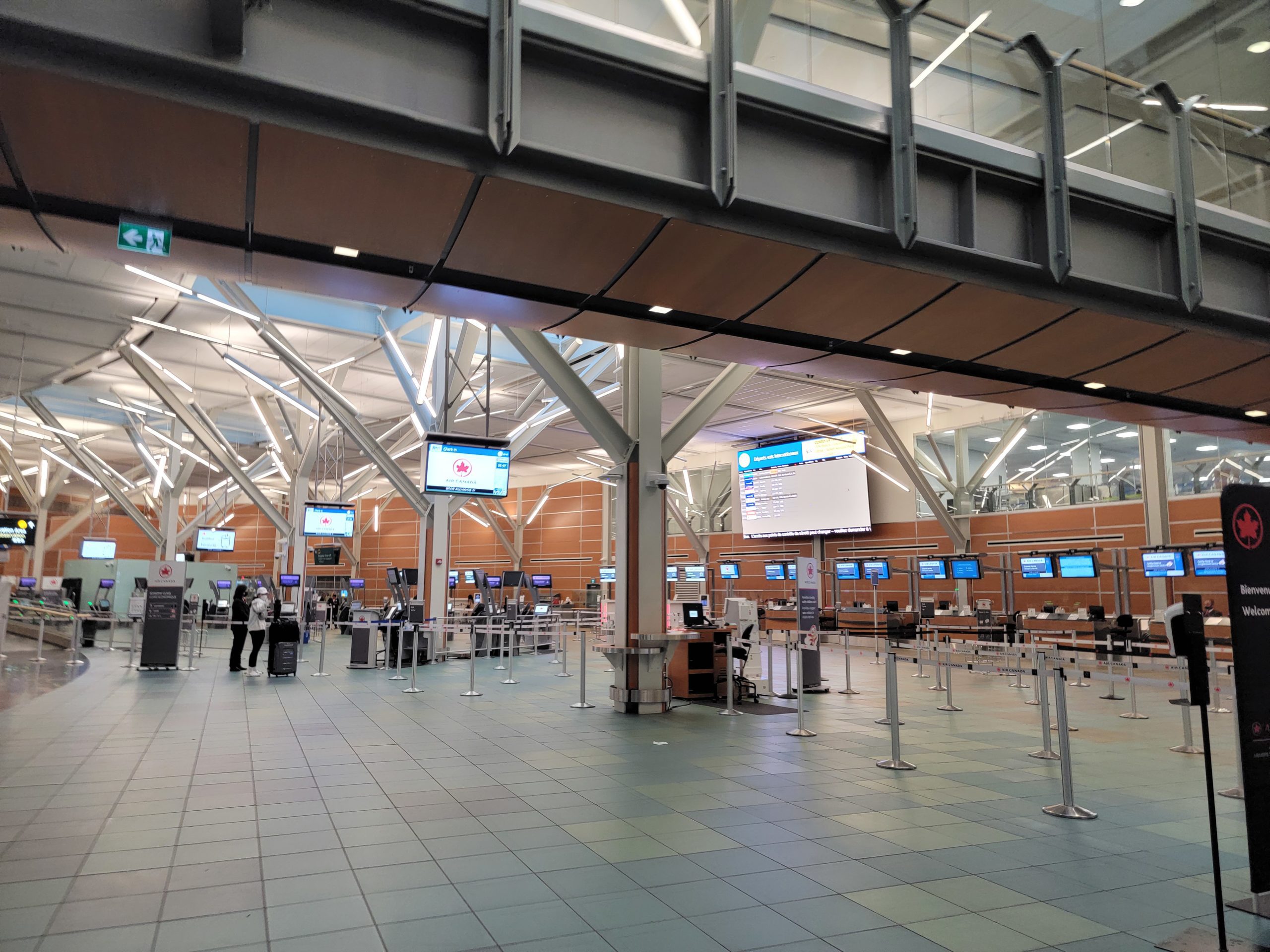
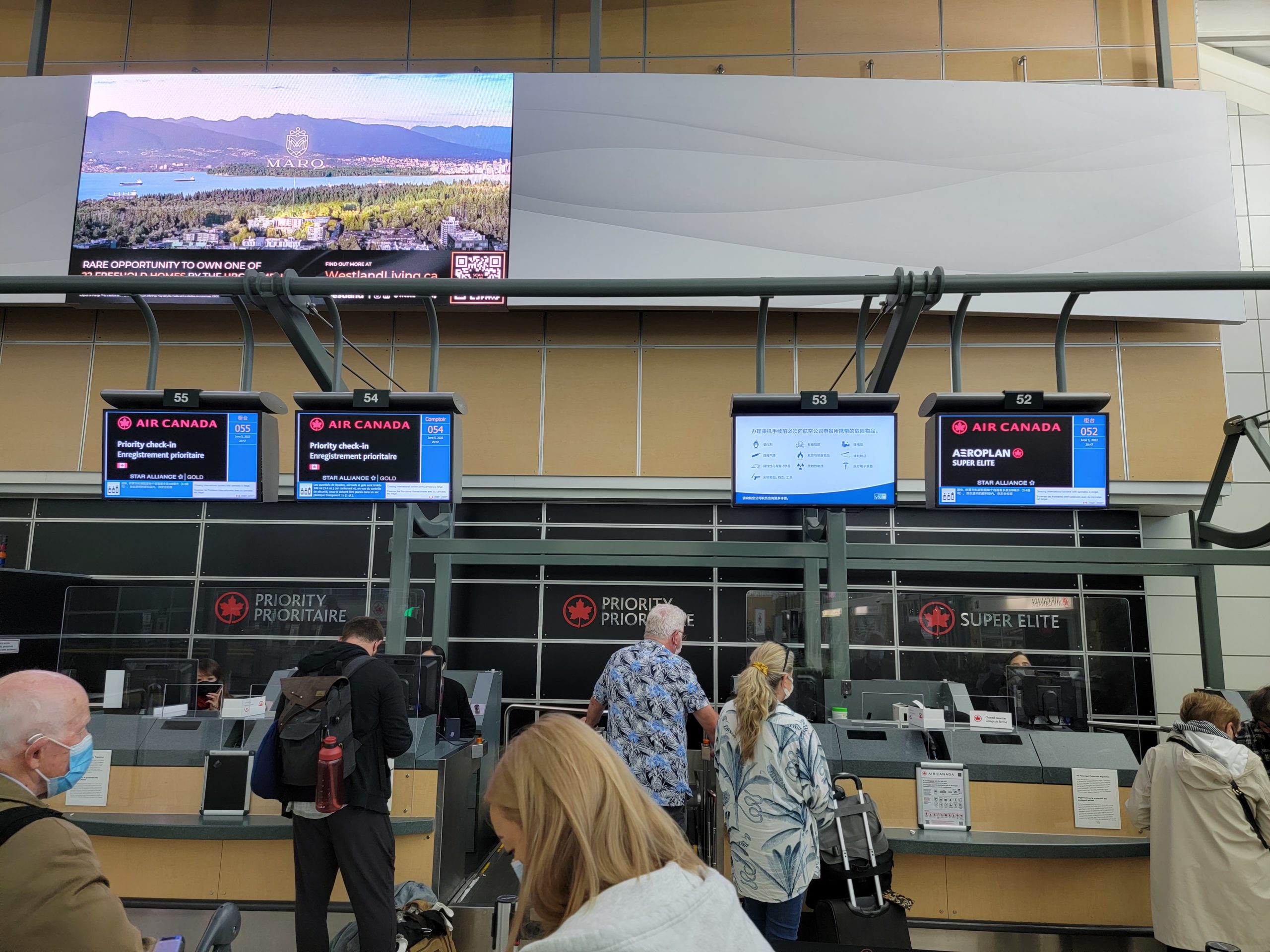
All things considered I was happy being assisted after about a 10 minute wait. It didn’t take long to work through our Australian predeparture approvals. Security for the international terminal was quick and painless. And we were on our way to the Air Canada Signature Suite.
Visiting The Air Canada Signature Suite Vancouver
The lounge is located just past security near gates 52 and 53. It is upstairs from Air Canada’s Maple Leaf Lounge.
We showed our boarding passes at the desk downstairs and were invited up to the Signature Suite. We took the elevator rather than the stairs.
Inside we were welcomed. My wife and daughter were with me. It was late – about 11:30 p.m. Central time (our home time zone) at this point – and our daughter was tired so she was in her stroller.
Lounge staff invited us to use the private dining room. The lounge was mostly empty, but I presumed this invitation (which would allow us to be more comfortable) was more for the benefit of other passengers in the lounge.

I had seen claims that the VIP room is highly restricted for access and also that it is available to families with young children.
I absolutely loved the Signature Suite in Toronto when I was there in late 2017, but it was a dark space without windows. The Vancouver Signature Suite has a fantastic windowline.
Here’s the view from inside the VIP dining room.
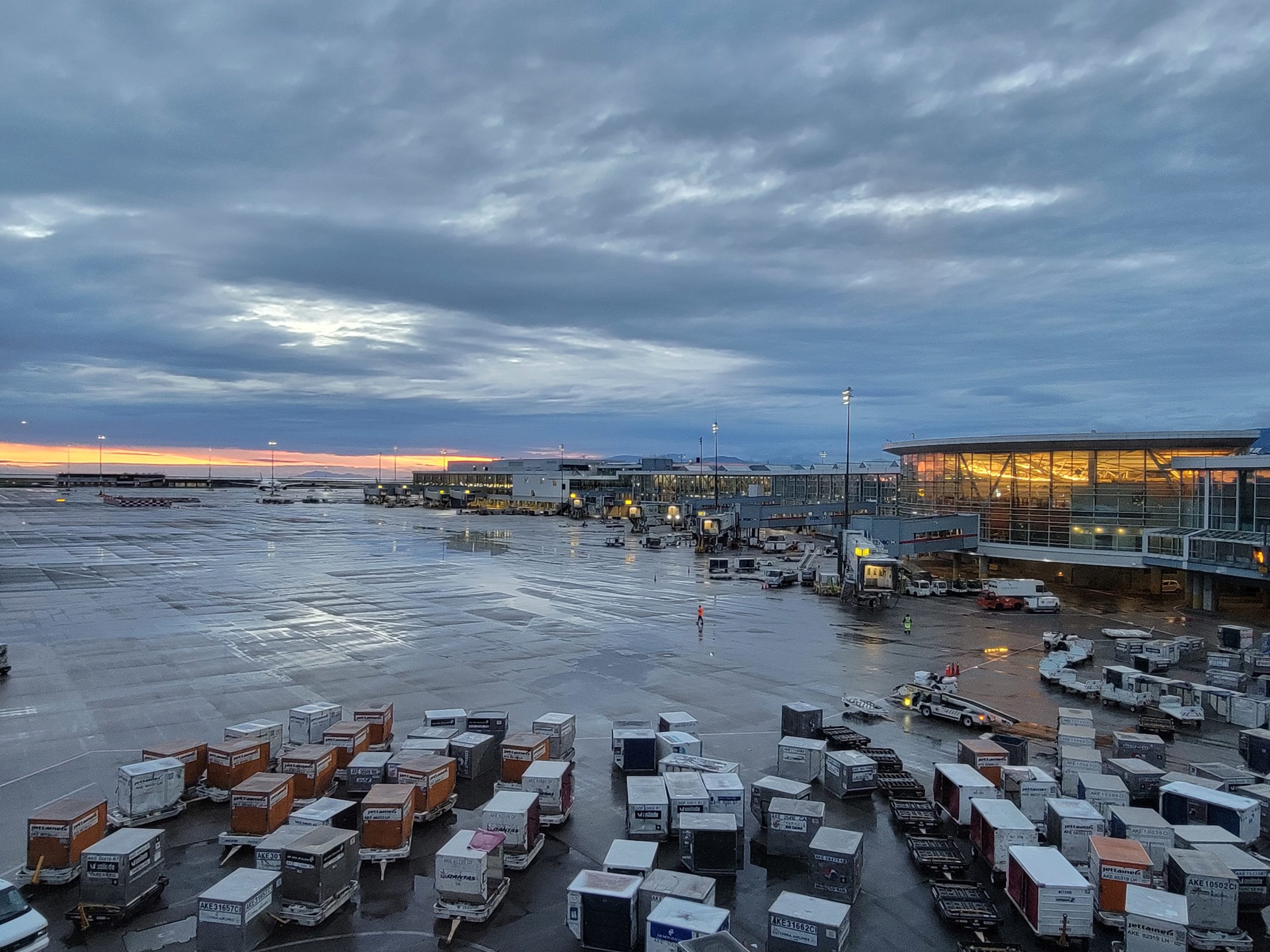
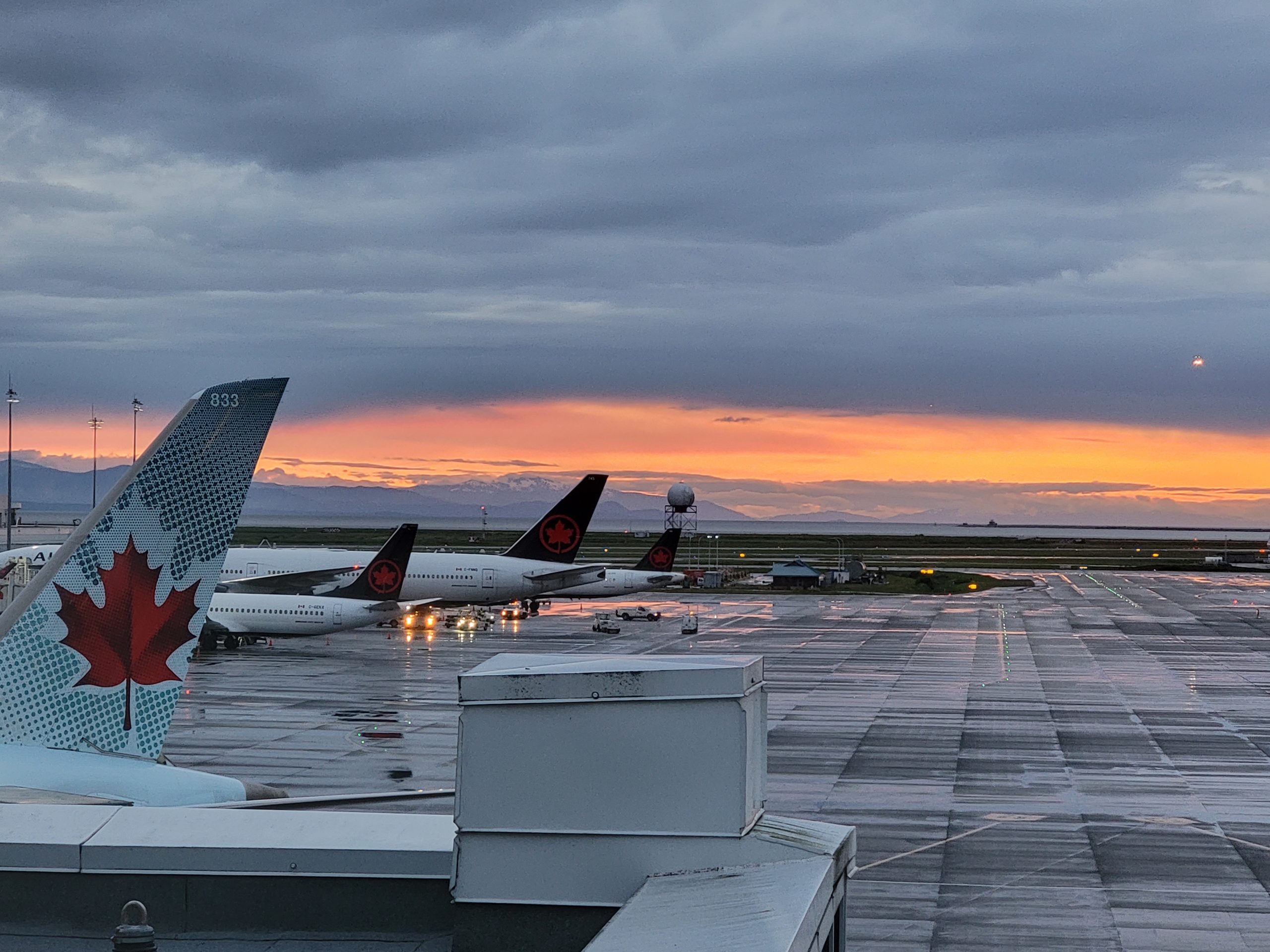
And here’s the bistro seating area beside it, which you can see has the same windowline.
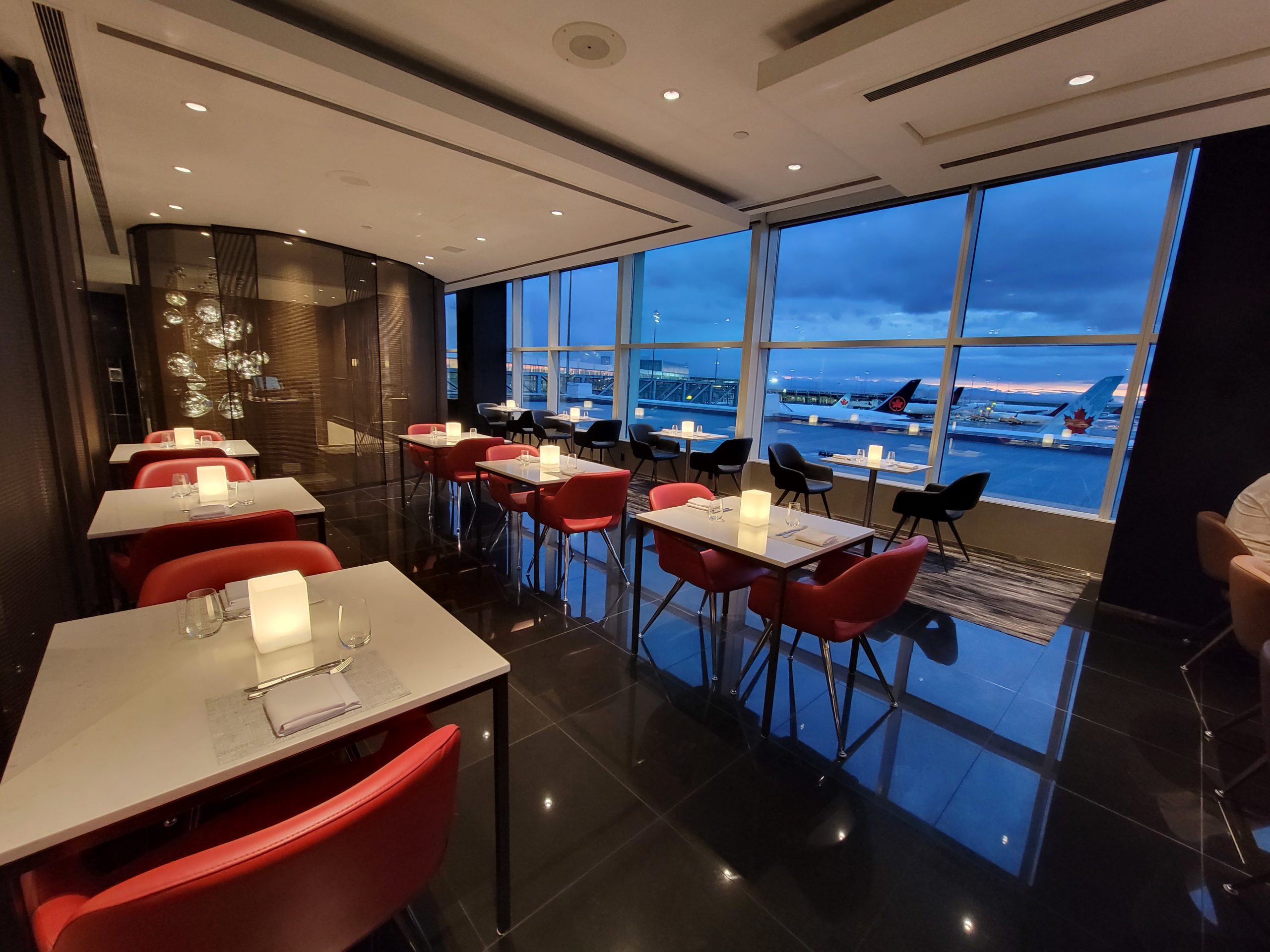
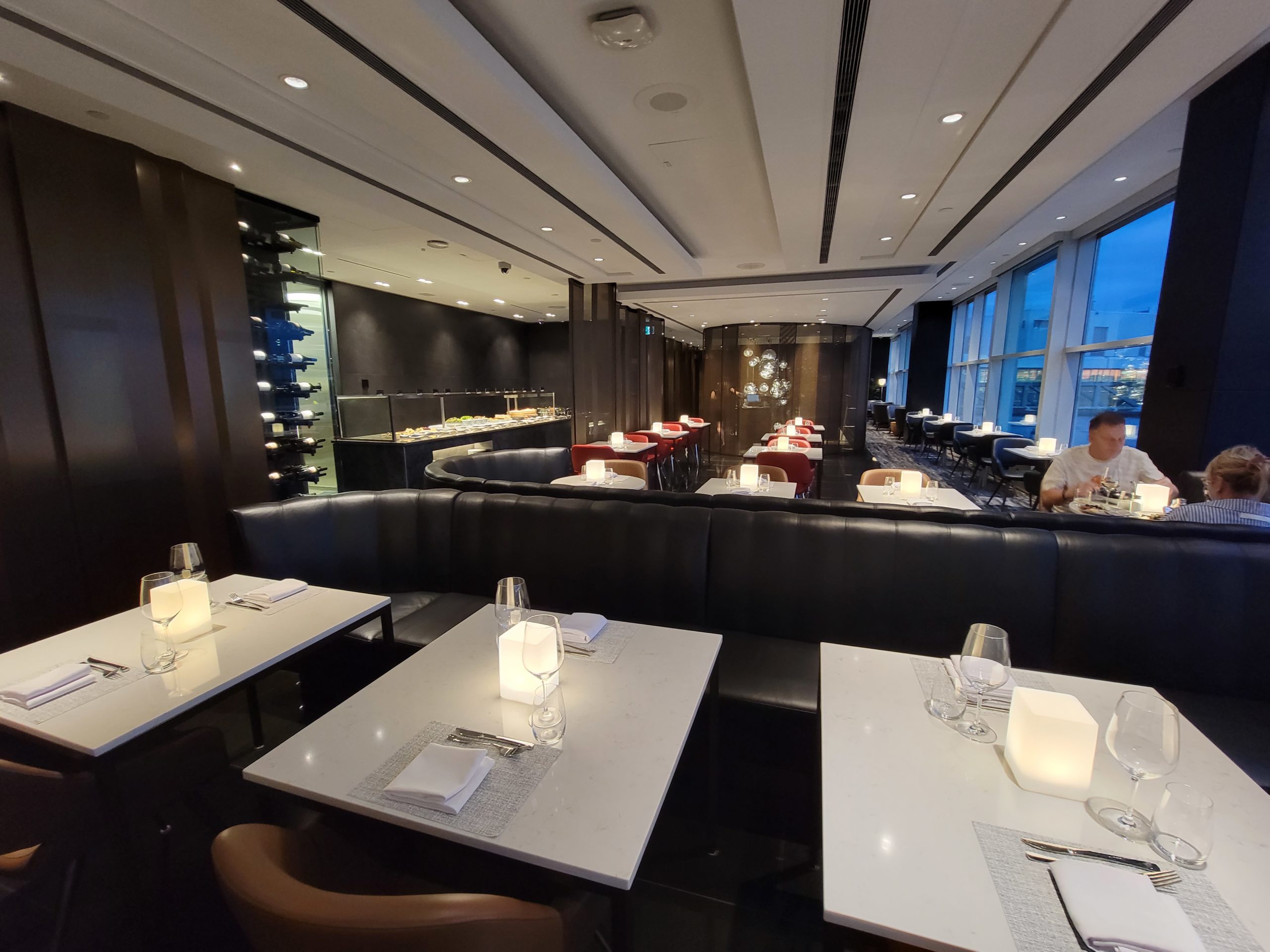
The bar is actually situated between the bistro area and VIP room.
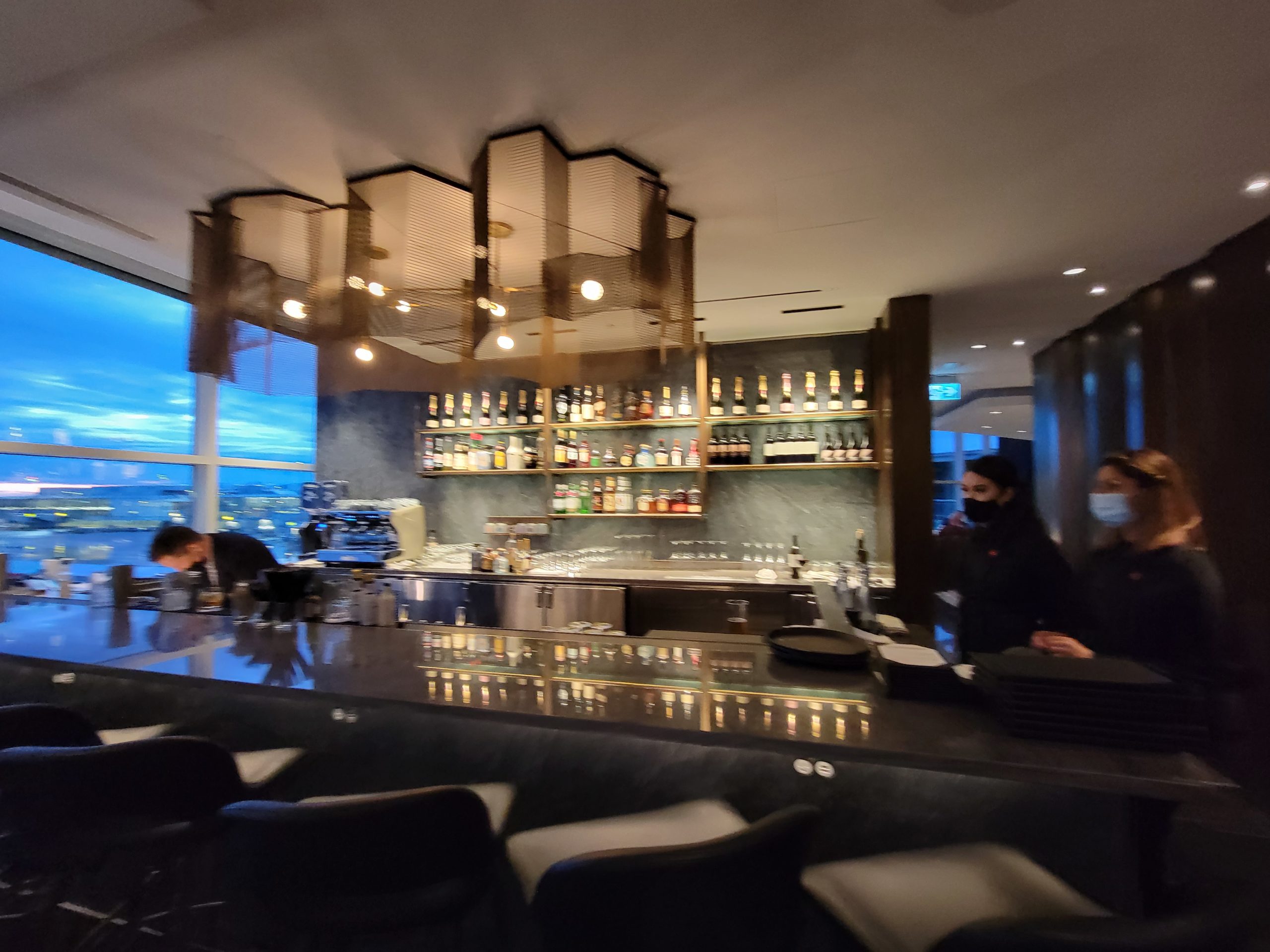
Beyond the bistro area, bar and VIP dining room is the lounge’s dining room.
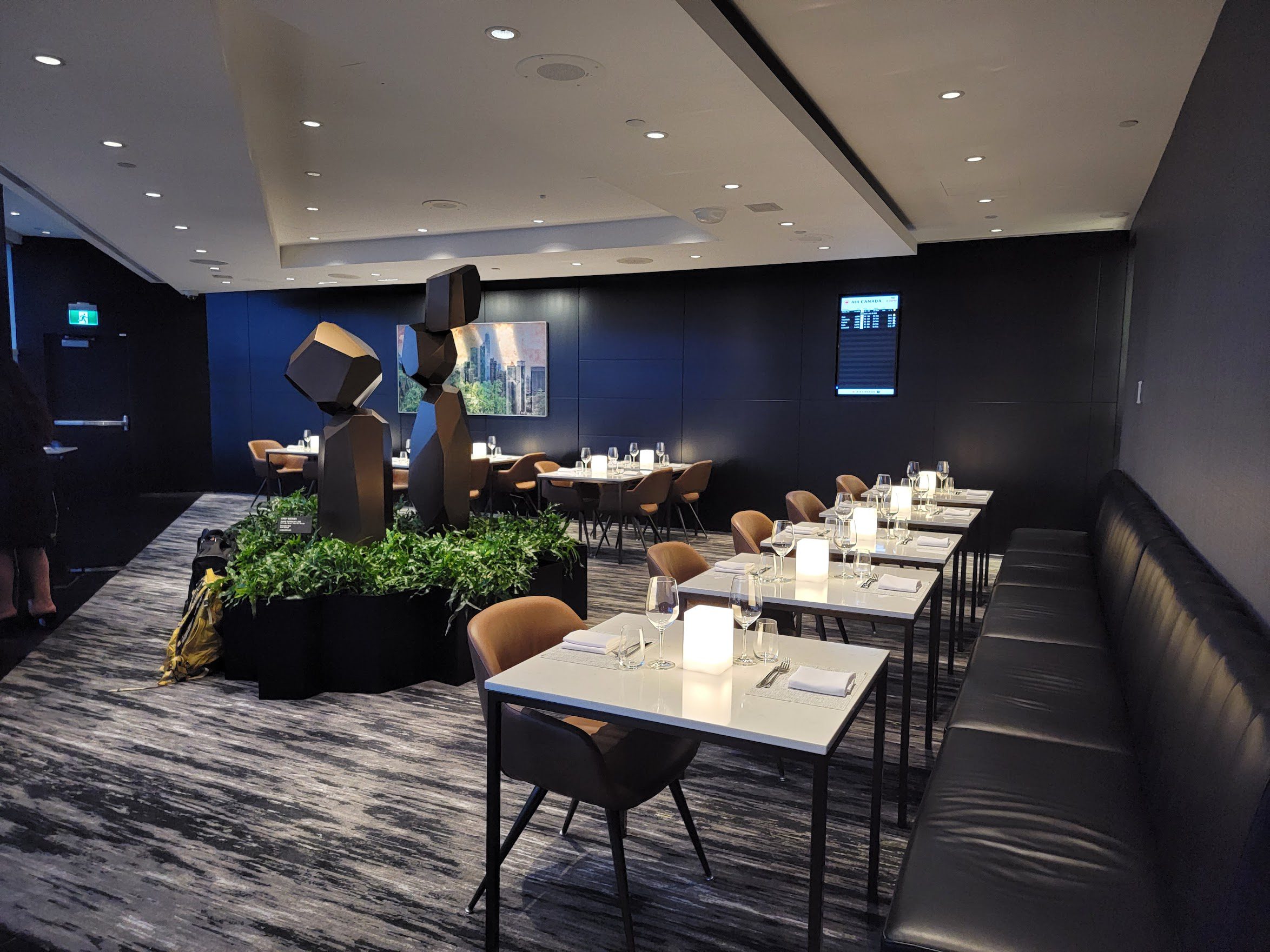
What the space lacks, at just 4400 square feet and seating for 105 guests, is work or relaxation areas. This really is a special dining room inside of a lounge rather than a standalone lounge as such.
Amazing Dining
What makes the Signature Suite special isn’t that it’s an exclusive space within the Air Canada lounge. What makes the lounge is the food – a nice buffet, sure, if you’re in a hurry but a menu to order from that’s a cut above other lounges with sit down dining.
The food here is better, for instance, than I’ve had in United Polaris lounges or Qantas First Class lounges (and the latter can be quite good). Signature Suite dining is curated by Canadian chef David Hawksworth.
First, here’s a look at the buffet:
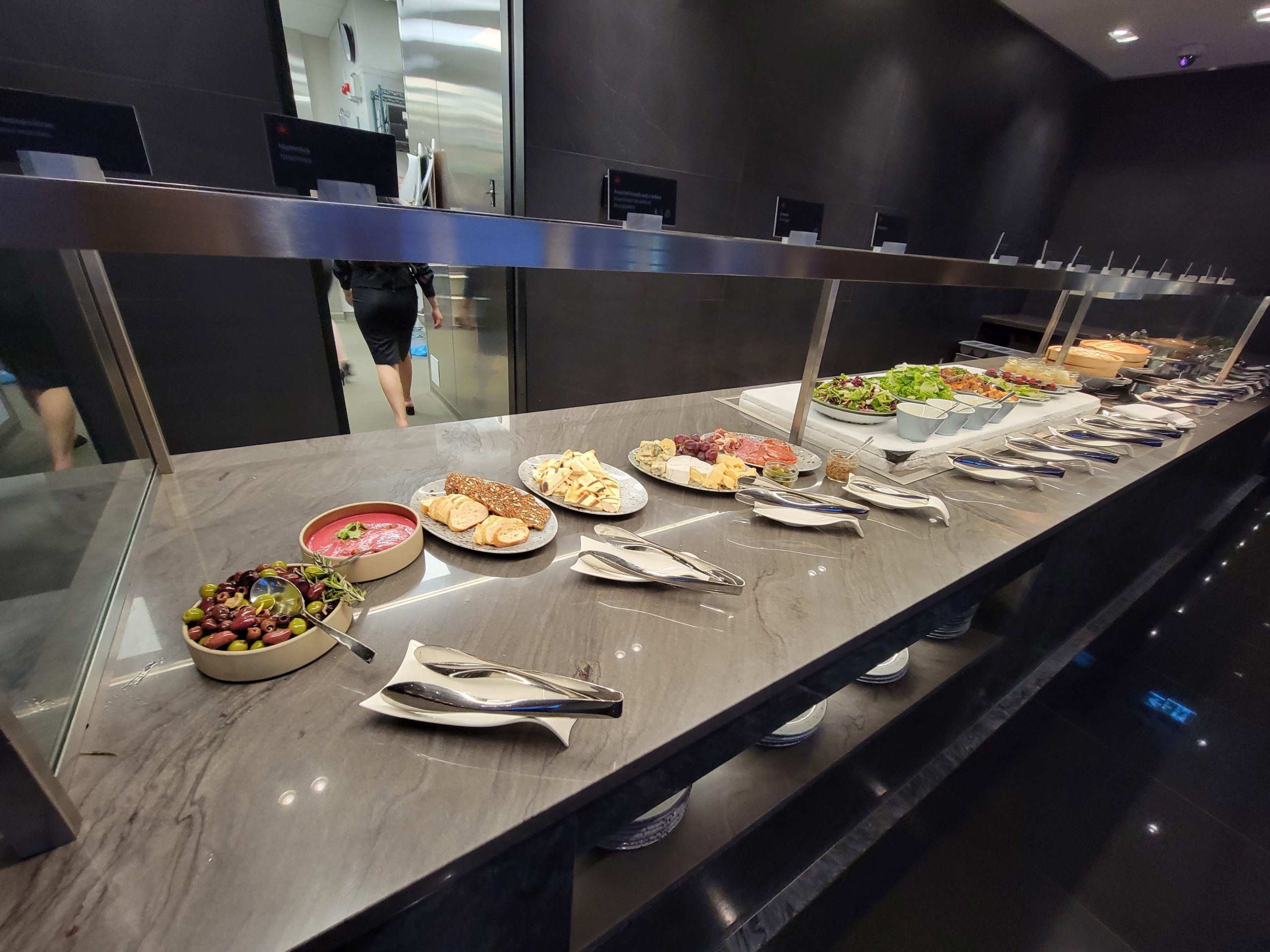

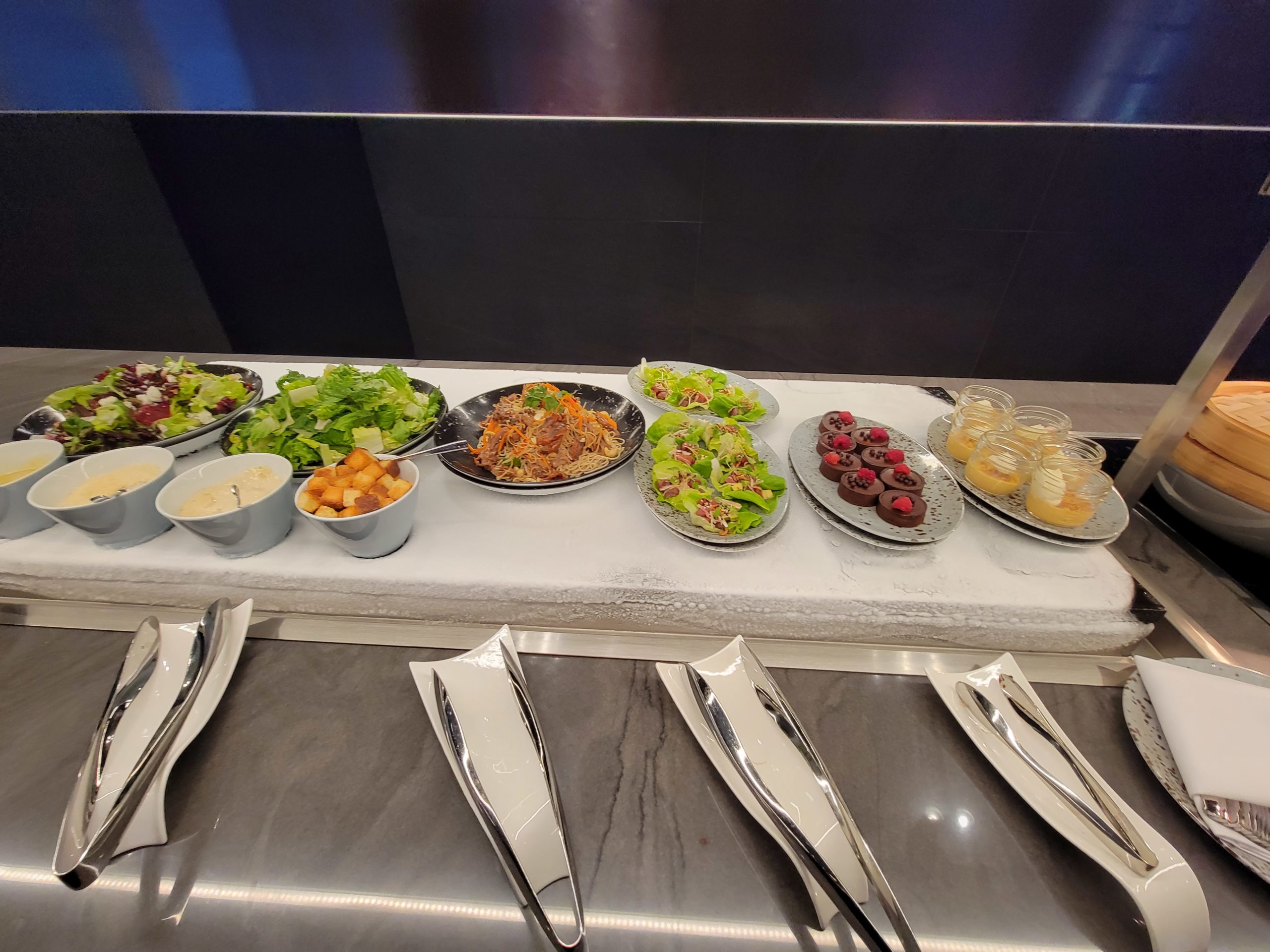


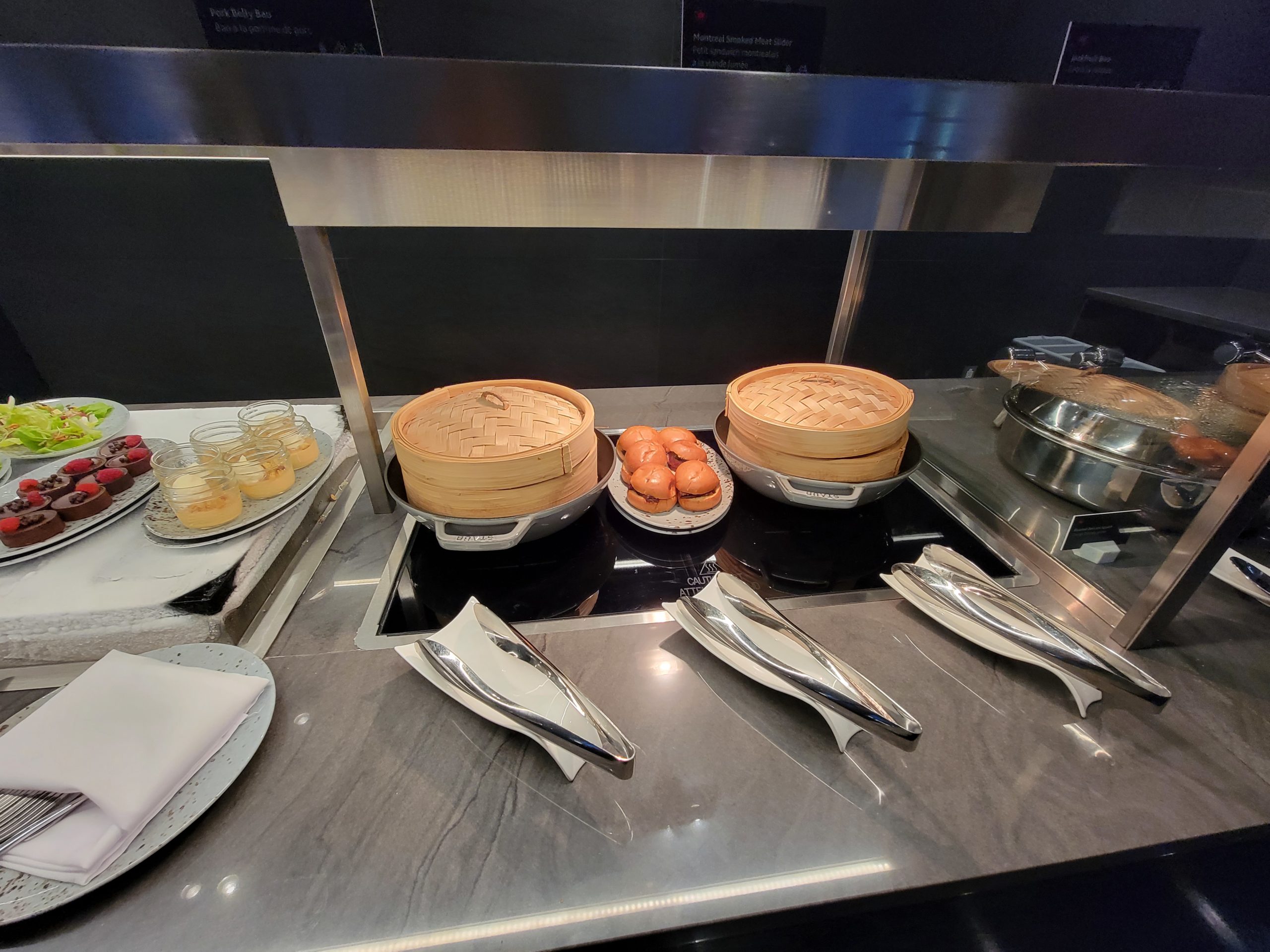
If you can, though, take he time to order off of the menu:
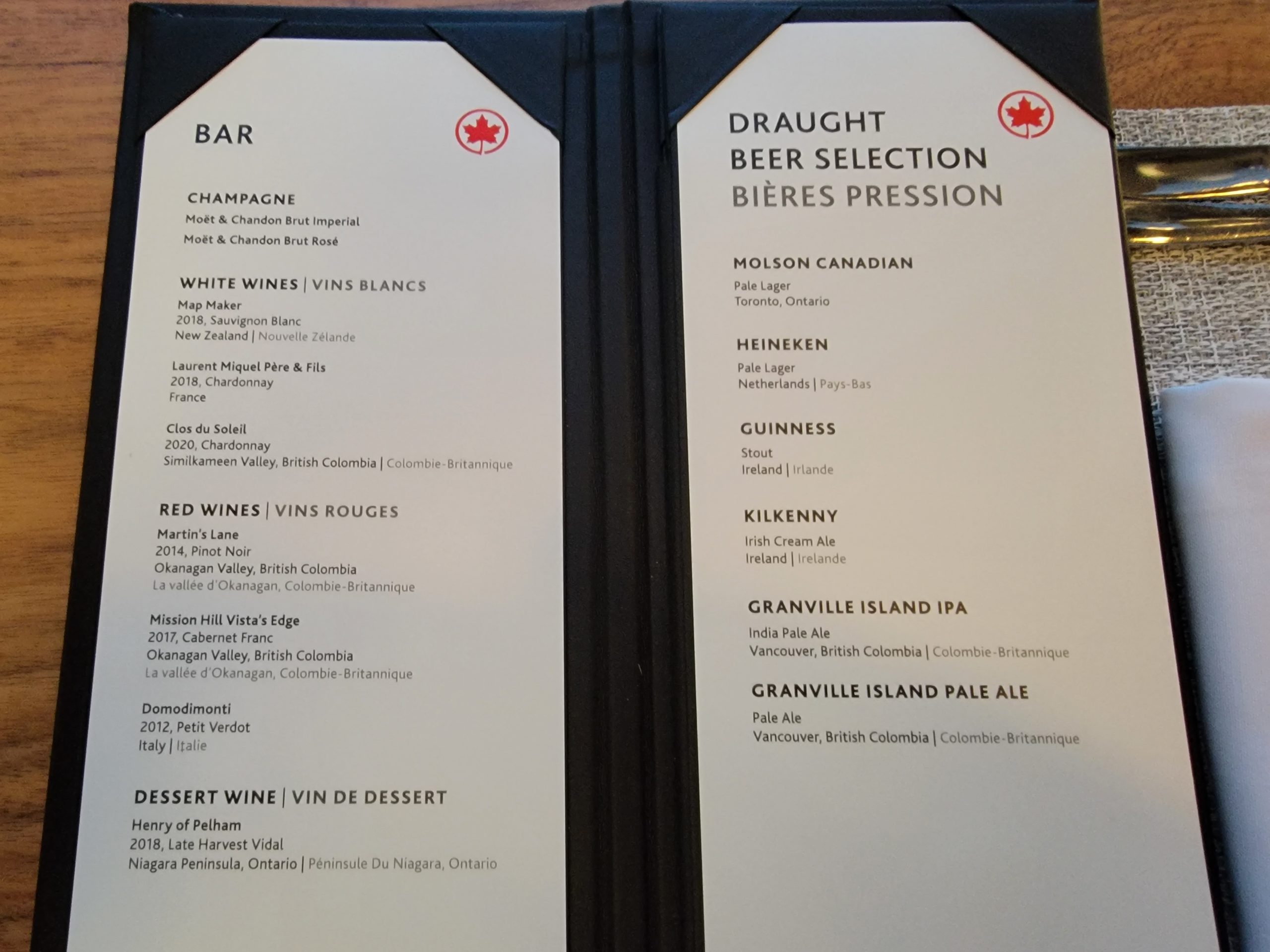
My Meal At The Air Canada Signature Suite Vancouver
I had really been looking forward to seared foie gras. I tried it in the Toronto Signature Suite four and a half years earlier and remembered it as very good. I had just been talking to my wife a week earlier about how I had a craving for seared foie gras, not thinking that I’d have an opportunity here.
I didn’t order it, though, because we were told they had a special tomahawk steak available, and would we like them to prepare it for us along with some sides? I didn’t feel like I could say no to that, and indeed it was excellent, but I missed out on the foie.
First, though, cocktails. I ordered the mandarin old fashioned which was excellent.

To pair with dinner we went with the Domodimonti Passione e Visione petit verdot. I was told they were down to a few cases, and they’d been cellaring since right before the pandemic when the lounge first opened.
Often in lounges and on planes they’re dealing with such quantities of wine that they are served too young. This bottle was aged perfectly, so I guess the lounge being closed for two years had an upside. It was enjoyable on its own and complemented our steaks perfectly.

We started with an amuse bouche and then staff brought out a couple of sides and salads served family-style for the three of us to eat (my three year old skipped the amuse’). The lounge chef proudly brought out the tomahawk steak, which isn’t something they normally have.







The meal was fantastic and our hour in the lounge was just enough time, or so we thought (the flight wound up being delayed about half an hour but there was no advance indication of this).
Enjoying dinner before such a late departure is perfect, in order to skip the onboard meal and go right to sleep. Enjoying dinner before such a long flight is perfect, too, because we were able to ask the crew to save our meals for later in the flight.
For a roughly 15 hour flight a meal at the start, one at the end, and 11 hours in-between really doesn’t seem like enough. To be sure there are snacks but it was so much nicer to have dinner, then have the inflight dinner around 8 hours later.
I questioned my sanity spending an extra 10,000 miles per person for access to this lounge, but I definitely enjoyed it enough that it was worth it and would pay the premium again.
-
 1
1
-
-
Air Canada Now Has 30 Airbus A220-300s
Chris Loh - 13h agoAir Canada
IATA/ICAO Code AC/ACA Airline Type Full Service Carrier Hub(s) Calgary International Airport, Montréal–Trudeau International Airport, Toronto Pearson International Airport, Vancouver International Airport Year Founded 1965 Alliance Star Alliance CEO Michael Rousseau Country CanadaAir Canada now has a fleet of 30 Airbus A220-300s after taking delivery of a new aircraft last week. Being an early customer for the type, the airline is expecting a total of 45 of these small narrowbodies by the end of 2025. Let's take a look at the delivery details of the latest aircraft.
Welcoming C-GVUO to the fleet
On June 18th, Airbus delivered Air Canada's 30th A220-300. The aircraft, registered C-GVUO, flew an uneventful flight from Montreal Mirabel (YMX) to Air Canada's largest hub, Toronto Pearson (YYZ). This flight took just under an hour, with the jet departing Mirabel at 11:40 and arriving in Toronto at 12:36.
While this is a fairly short delivery flight, this would probably be the second-shortest delivery service for an A220 built at Mirabel. That's because Air Canada also has a hub at Montreal's Pierre Elliott Trudeau International Airport - which is located just 33km from Airbus' Canadian A220 assembly facility. Indeed, driving by car would take less than 40 minutes to cover the 50km of road. If we take C-GNBE as an example, the one-year-old A220 was delivered from Mirabel to Trudeau on March 31st, 2021, with a flight time of just 13 minutes. This is a much shorter flight than delivering the same aircraft type to airBaltic, with a flight from Montreal to Riga taking roughly seven and a half hours.
The delivery flight from Mirabel to Pearson. Photo: FlightRadar24.com2/3rds complete for A220-300 order
With the delivery of this 30th aircraft, Air Canada's order for the Airbus A220-300 is now two-thirds complete. The airline first ordered the aircraft type back in February 2016 when it was still known as the Bombardier CSeries.
The Canadian carrier has, for the most part, held firm to this order for 45 aircraft, although this waivered slightly during the pandemic. It was back in November 2020 that Air Canada announced that it would be canceling part of its order, reducing its commitment by 12 jets amid the health crisis and its devastating impact on the travel industry. However, when the situation began to improve over the course of 2021, the carrier took the small step of reversing the cancelation of two A220s. Just a few months later, in February 2022, the airline announced that it was reinstating its order for all 12 of the previously canceled jets.Speaking about the change of direction, newly installed Air Canada President and CEO Michael Rousseau stated the following in November 2021:
"We are encouraged by the favorable revenue and traffic trends in the third quarter, with strong increases in key passenger geographic segments, a record cargo performance, and significant improvements in both Air Canada Vacations and Aeroplan,"
The remaining 15 aircraft will arrive between now and 2025.
The airline took delivery of its first A220 in 2019. Photo: Air CanadaLong-and-skinny exemplified
The A220 is well-suited to Canada's domestic aviation scene. With a relatively small population for its massive territory, long-and-skinny trans-continental services would benefit greatly from an efficient performer like the Airbus A220-300. Good examples of such Air Canada services include flights from Montreal to Kelowna, San Diego, and Seattle.
-

Here’s everything Air Canada is doing to keep travel moving this summer
ShareMONTREAL — Air Canada is outlining all the measures the company is taking during this extraordinary time of travel’s resurgence, after comments from the federal government that airlines must own their role in the current challenges at airport chaos.
For months now long lineups and delays at Canada’s biggest airports, particularly Pearson Airport, have frustrated travellers and the travel industry, especially on the heels of two years of travel shutdowns.
The federal government issued its latest update earlier this week, highlighting the measures its taken to alleviate the chaos.
As reported yesterday, Transport Minister Omar Alghabra, later said: “Airlines have a duty as well. We’re hearing some stories about luggage issues and flights cancelling. We’re making sure that the airlines keep up their end of the bargain.”
The National Airlines Council of Canada, which represents carriers including Air Canada, Transat and more, says they’ve already done that. “The delays at Canada’s airports are not due to staffing at levels at airlines, but rather due to the workforce challenges at NAV Canada (which runs the country’s air navigation service), CATSA and CBSA which have a cascading effect on flight schedules and resources across the ecosystem,” said Suzanne Acton-Gervais.
STATEMENT FROM MICHAEL ROUSSEAU
Following up on the NACC’s input, Air Canada has released a statement from President and CEO Michael Rousseau, following a meeting yesterday of senior Air Canada representatives and other key participants in the Canadian aviation industry and Minister Alghabra.
“At Air Canada, we know every trip is important, even more so today as many are flying for the first time in years to see loved ones or take an eagerly anticipated holiday. We are determined not to disappoint and have been long preparing for a travel surge this summer, including coordinating with our industry partners. As all businesses worldwide are finding, restarting after COVID is an extremely complex task and we deeply appreciate our customers’ understanding and patience during these often-frustrating times,” said Rousseau.
He notes that every day Air Canada currently operates more than 1,000 flights and regularly carries more than 120,000 people, with the vast majority of scheduled flights successfully completed.
“In recognition of the high importance Canadians place on travel and its value to the Canadian economy, Air Canada has recommitted to keep working alongside its industry partners and with the federal government to ensure Canadians continue to benefit from a safe, efficient and reliable air transportation system,” Rousseau said.
Here’s a roundup …
CUSTOMER INITIATIVES
- New Self-Service Re-accommodation tools will allow customers who have schedule changes, delays, or cancellations to request a refund if eligible or rebook their itineraries in a few minutes through its mobile app or website. This includes getting up to 20 alternative flight options (based on availability), choosing to fly to nearby airports instead, and the ability to search for flights in a three-day window. It’s available for customers regardless of how and where they booked their tickets;
- A goodwill policy has been implemented for passengers traveling via Toronto-Pearson to allow them to voluntarily increase their connection time at no cost for more flexibility when travelling. This policy can be applied within 48 hours of the original travel time;
- A second new policy will allow customers free, same-day stand-by options for earlier flights within Canada/Transborder regardless of fare brand or booking class;
- The airline maintains an updated travel readiness page on aircanada.com with the latest information and advice for those preparing to travel, including information about COVID-19 requirements. Customers are advised to consult this page before travelling.
IN AIRPORTS
- In addition to the recall of virtually all available Air Canada employees, more than 2,000 front-line airport employees (and 774 more people to work in call centres) have been hired and extensively trained over the last six months, with additional overtime and ongoing hiring, including drawing upon recently retired employees with special expertise;
- Employees have been reassigned from other bases to augment specific airports, including the cross-utilization of cargo employees to assist with airport passenger operations;
- Redeployed aircraft from the Jetz charter fleet to move delayed baggage, which has increased in large part due to air transport processing and infrastructure issues outside its control;
- Working closely with airport authorities, government and third-party agencies to enhance and expedite the processing of customers throughout their journey;
- Additional ground equipment has been acquired to improve airport operations.
NETWORK / SCHEDULE
- Minimum Connection Times for flights from international and transborder destinations connecting to domestic destinations have been increased by 30 minutes for new bookings in Toronto and Montreal, giving customers (and their baggage) additional time to connect;
- The schedule has been refined to reduce peak times at the Toronto-Pearson and Montreal-Trudeau airports by retiming and cancelling certain flights, or reducing frequencies, where protection is available to customers the same day. This will conserve resources and reduce stress on third-party service providers by smoothing passenger flows and be more convenient for customers;
- Aircraft gating at airports has been reconfigured. For example, widebody aircraft in Montreal travelling internationally and to the U.S. are being more conveniently located to achieve efficiencies during peak hours for added operational flexibility.
-
 1
1
-
1 hour ago, MCPSPEED said:
Of course the luggage had to have been offloaded. I’m sure it did and this was embellished.
Talk about the perfect plan. Check you luggage with an explosive, cause a scene to get kicked off and watch the plane takeoff

I can not find any regulations that require the removal of the baggage. Can you point to either law in Canada or Britain ?
-
better safe than sorry but disappointing
QuoteTechnical issue temporarily stops Canadian Forces Snowbirds from flight performances

OTTAWA — The Department of National Defence says the Canadian Forces Snowbirds will be unable to fly in planned air shows and flypasts until a technical issue is resolved.
That means performances next Wednesday in the Moncton, N.B., area will be cancelled while technicians work to get the team back in the air for Canada Day in Ottawa.
The department says in a news release the issue relates to a device that sets the timing for the deployment of the parachute during the ejection sequence.It says during routine maintenance, technicians discovered the tool may not be calibrated accurately and the parachutes will now be retested and repacked to ensure proper timing for their activation in the event of an emergency.
It's not known how long it will take to fix the issue, but the release says the Royal Canadian Air Force is working with experts and a third-party aviation contractor to get the team back in the air as soon as it is safe to do so.
It adds Air Force experts have determined there is no link between the 2020 crash in Kamloops, B.C., that killed Capt. Jenn Casey — which occurred after a bird flew into an engine — and the current issue with the parachute device.
This report by The Canadian Press was first published June 24, 2022.
The Canadian Press
-
I bet not everyone will agree....
QuoteCanada has 3 of the world’s most liveable cities in 2022
Michelle Butterfield - Yesterday 4:02 p.m.React80 Comments|Toronto and Vancouver might hog the spotlight when it comes to well-known Canadian cities, but it turns out Calgary is the best place to live – at least this year.
The annual ranking of the world's most liveable cities has been released by the Economist Intelligence Unit (EIU), and 2022's Global Liveability Index, and Canada was the biggest winner, with three of its cities nabbing a spot in the top 10.
Cowtown, as it's affectionately known, grabs not only the honour of being the top-ranked Canadian city on the list, but also comes in at #3, worldwide.
The ranking rates 172 cities around the world on over 30 factors, including access to healthcare, amount of green space, cultural and sports activities, crime rates and infrastructure.
"The concept of liveability is simple: It assesses which locations around the world provide the best or the worst living conditions," the Economist report states. A score of 1 is "intolerable," according to the EIU, while 100 is "ideal."
Each year the list typically has many North America and western European cities claim top honours, and this year is no exception. Vienna, Austria claimed the top spot, followed by Copenhagen, Denmark. Zurich, Switzerland and Calgary tied for third spot. Vancouver followed just behind, claiming the fifth position.
However, factors like war, unrest, and the ability to cope with COVID played into the rankings, meaning there were some key shifts when comparing this year's rankings to 2021's list.
Calgary, the third-largest municipality in Canada as ranked by StatCan, rose 15 spots since 2021, fueled by the city's early easing of pandemic restrictions. The city garnered a score of 96.3.
Vancouver, which had fallen out of the Top 10 in 2021, was nipping closely on Calgary's heels with a score of 96.1.
Toronto found its way back to a top spot, coming in eight after falling out of the top 10 in 2021.
Read more:
Work-life balance: These 4 Canadian cities are ranked among top 20 globally
Auckland, New Zealand fell to 33rd place this year – a mighty plunge from last year's first-place ranking, which was secured when the country closed its borders due to the pandemic and allowed residents to live fairly normal lives.
Similarly, while Australia claimed four spots in the top 10 last year due to excellent quality of life and limited restrictions during the pandemic, three of those cities — Brisbane, Adelaide and Perth — fell out of the top 10 this year as much of the world lifted COVID restrictions.
"Western European and Canadian cities dominate the top of our rankings," the report stated. "Life is almost back to normal in these cities on account of high COVID-19 vaccination rates and the easing of restrictions."
The rankings also note that Kyiv, Ukraine was not assessed this year due to the geopolitical unrest caused when Russia invaded in February. Russian cities Moscow and St. Petersburg also fell low in the rankings over "censorship" and the impact of western sanctions.
Read more:
Toronto is the 4th best city in the world for Gen Z. But can they afford it?
The Economist warns that no ranking is forever, though, and that due to rising inflation, fuel costs, and unstable food supply, next year's rankings could look much different.
"The welcome rise in liveability this year might be short-lived," the publication wrote.
TOP 10 CITIES
1. Vienna, Austria
2. Copenhagen, Denmark
3. Zurich, Switzerland (tie)
3. Calgary, Canada (tie)
5. Vancouver, Canada
6. Geneva, Switzerland
7. Frankfurt, Germany
8. Toronto, Canada
9. Amsterdam, Netherlands
10. Osaka, Japan (tie)
10. Melbourne, Australia (tie)
Video: These Canadians cities were ranked among the best in the world to drive in
MMAdd a comment80
-
Quote
NASA's Curiosity Captures Stunning Views of a Changing Mars Landscape
by Staff Writers
Pasadena CA (JPL) Jun 23, 2022
NASA's Curiosity Mars rover captured this view of layered, flaky rocks believed to have formed in an ancient streambed or small pond. The six images that make up this mosaic were captured using Curiosity's Mast Camera, or Mastcam, on June 2, 2022, the 3,492nd Martian day, or sol, of the mission. Credit: NASA/JPL-Caltech/MSSSStriking rock formations documented by the rover provide evidence of a drying climate in the Red Planet's ancient past.
For the past year, NASA's Curiosity Mars rover has been traveling through a transition zone from a clay-rich region to one filled with a salty mineral called sulfate. While the science team targeted the clay-rich region and the sulfate-laden one for evidence each can offer about Mars' watery past, the transition zone is proving to be scientifically fascinating as well. In fact, this transition may provide the record of a major shift in Mars' climate billions of years ago that scientists are just beginning to understand.
The clay minerals formed when lakes and streams once rippled across Gale Crater, depositing sediment at what is now the base of Mount Sharp, the 3-mile-tall (5-kilometer-tall) mountain whose foothills Curiosity has been ascending since 2014. Higher on the mountain in the transition zone, Curiosity's observations show that the streams dried into trickles and sand dunes formed above the lake sediments.
"We no longer see the lake deposits that we saw for years lower on Mount Sharp," said Ashwin Vasavada, Curiosity's project scientist at NASA's Jet Propulsion Laboratory in Southern California. "Instead, we see lots of evidence of drier climates, like dry dunes that occasionally had streams running around them. That's a big change from the lakes that persisted for perhaps millions of years before."
As the rover climbs higher through the transition zone, it is detecting less clay and more sulfate. Curiosity will soon drill the last rock sample it will take in this zone, providing a more detailed glimpse into the changing mineral composition of these rocks.
Unique geologic features also stand out in this zone. The hills in the area likely began in a dry environment of large, wind-swept sand dunes, hardening into rock over time. Interspersed in the remains of these dunes are other sediments carried by water, perhaps deposited in ponds or small streams that once wove among the dunes. These sediments now appear as erosion-resistant stacks of flaky layers, like one nicknamed "The Prow."
Making the story richer yet more complicated is the knowledge that there were multiple periods in which groundwater ebbed and flowed over time, leaving a jumble of puzzle pieces for Curiosity's scientists to assemble into an accurate timeline.
Ten Years On, Going Strong
Curiosity will celebrate its 10th year on Mars Aug. 5. While the rover is showing its age after a full decade of exploring, nothing has prevented it from continuing its ascent.On June 7, Curiosity went into safe mode after detecting a temperature reading on an instrument control box within the body of the rover that was warmer than expected. Safe mode occurs when a spacecraft senses an issue and automatically shuts down all but its most essential functions so that engineers can assess the situation.
Although Curiosity exited safe mode and returned to normal operations two days later, JPL's engineers are still analyzing the exact cause of the issue. They suspect safe mode was triggered after a temperature sensor provided an inaccurate measurement, and there's no sign it will significantly affect rover operations since backup temperature sensors can ensure the electronics within the rover body aren't getting too hot.
The rover's aluminum wheels are also showing signs of wear. On June 4, the engineering team commanded Curiosity to take new pictures of its wheels - something it had been doing every 3,281 feet (1,000 meters) to check their overall health.
The team discovered that the left middle wheel had damaged one of its grousers, the zig-zagging treads along Curiosity's wheels. This particular wheel already had four broken grousers, so now five of its 19 grousers are broken.
The previously damaged grousers attracted attention online recently because some of the metal "skin" between them appears to have fallen out of the wheel in the past few months, leaving a gap.
The team has decided to increase its wheel imaging to every 1,640 feet (500 meters) - a return to the original cadence. A traction control algorithm had slowed wheel wear enough to justify increasing the distance between imaging.
"We have proven through ground testing that we can safely drive on the wheel rims if necessary," said Megan Lin, Curiosity's project manager at JPL. "If we ever reached the point that a single wheel had broken a majority of its grousers, we could do a controlled break to shed the pieces that are left. Due to recent trends, it seems unlikely that we would need to take such action. The wheels are holding up well, providing the traction we need to continue our climb."
Video: How Scientists Study Wind on Mars (NASA Mars News Report June 22, 2022)
-
 1
1
-
-
KF Aerospace hosts Career Fair on July 7th

June 22, 2022
Kelowna’s largest private sector employer is hiring for over 100 new positions at its headquarters in Kelowna, BC.
KF Aerospace is opening its hangar doors for a Career Fair on Thursday, July 7th. You’re invited for an exclusive inside look at a variety of career opportunities with KF’s world-leading aviation services.
The open-house event will showcase both skilled trades and entry-level roles including aircraft interior technician, hangar support, customer service and materials coordinator. Human Resources Manager, Susan van Unen says applicants of all backgrounds are welcome. “For our entry level roles, we provide on-the-job training that allows you to work towards a nationally recognized certification,” she says. “If you have a great attitude and are ready to learn and grow with us, we’d love to meet you.”
Okanagan College will be available to introduce prospective students to the Aircraft Maintenance Engineer (AME) training programs. Guests can also join guided tours of the facility and meet with KF staff to learn about other professional avenues including aerospace engineering, logistics, supply chain, administration and IT.
The company expects to fill over 100 jobs by 2023 to support growing demand for its aircraft maintenance and modification services, says Chief Corporate Services Officer, Grant Stevens. “We are increasing both staffing and hangar space to accommodate our upcoming passenger to freighter conversion program for Boeing and our aircraft leasing division,” he says. Facility expansion projects will add 40,000 sq feet to KF’s Kelowna base this year. An onsite café recently opened, and a YMCA daycare facility for the YLW Airport Campus is also scheduled to open in 2023, with dedicated spaces for KF families.
KF is proud to offer its staff industry competitive wages, a comprehensive employee benefits package with extended medical and dental coverage, paid time-off, career advancement and an annual profit-sharing program.
The KF Aerospace Career Fair takes place from 3:00 to 7:00 pm on Thursday, July 7thin KF’s West Hangar at 5650 Aerospace Drive in Kelowna. Free parking will be provided.
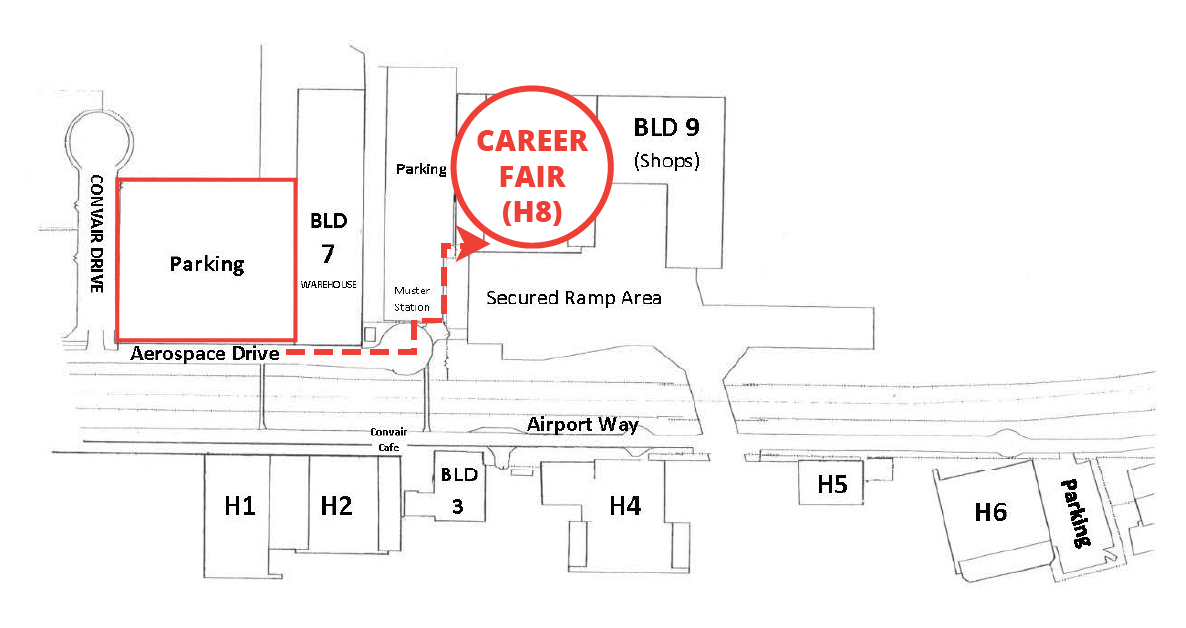
About KF Aerospace
We’re all about THE CRAFT.
For 52 years, KF Aerospace has delivered innovative aircraft solutions for corporate, commercial and military customers worldwide—including OEM’s like Boeing; major airlines like WestJet, Sunwing, Cargojet, Lynden Air Cargo and Icelandair; and the RCAF. From humble roots in the Okanagan Valley, KF has grown to specialize in aircraft maintenance and modifications, military aircrew training, air cargo operations and leasing—with the same commitment to quality and service established by its founder in 1970. KF Aerospace is Kelowna’s largest private sector employer with nearly 800 staff in the Okanagan, and over 1,000 staff across Canada.
Related
-
Flair Airlines shakes off regulator's scrutiny — now can it survive the market?
Discount upstart faces steep challenge in airspace dominated by two giants
Author of the article:Meghan PotkinsPublishing date:air Airlines Ltd.'s future looked anything but assured in April when it became clear that an investigation by the Canadian Transportation Agency (CTA) had raised serious questions about the airline's relationship with its American backer, private-equity firm 777 Partners Ltd. PHOTO BY FLAIR AIRLINESFlair Airlines Ltd. is clearly relishing this moment. The upstart carrier prevailed in a recent ruling by Canada’s aviation regulator that deemed the company sufficiently Canadian to continue flying domestically. Flair responded with a flash seat sale, discounting fares by 50 per cent, and let loose a blast of triumphant tweets: “We’re here… still,” the company cheekily wrote. “Blue skies ahead.”
Article content
It wasn’t obvious a few months ago that Flair would still be flying this summer.
The discount carrier’s future looked anything but assured in April when it became clear that an investigation by the Canadian Transportation Agency (CTA) had raised serious questions about the airline’s relationship with its American backer, private-equity firm 777 Partners Ltd. The CTA first suggested in March that Flair could be in violation of Canadian foreign ownership rules, and, as a result, faced the potential loss of its operating licence.
In the intervening weeks, Flair scrambled to overhaul its shareholder agreement, stripping 777 of unique veto rights and pledging to boost the number of Canadian directors on its board. The Edmonton-based airline also amended a loan agreement with 777 in a bid to decrease the American investor’s ability to exert control over Flair.
“Though we never doubted it, it’s still amazing for us to stand here today and say that Flair is Canadian,” chief executive Stephen Jones told reporters at a press conference staged at an Edmonton airport hangar. “The question has been answered. It’s done.”
As a result, the upstart carrier is set to continue its aggressive expansion in Canada’s duopolistic market, using the ultra-low-cost carrier model perfected by the likes of Ryanair Holdings PLC and Wizz Air Hungary Ltd. in Europe and Spirit Airlines Inc. in the United States. The company is emerging from the pandemic with 14 aircraft, plans to add five more to its fleet by July, and have 30 by mid-2023.
But to understand how close Flair came to being grounded by the CTA, it’s worth looking at the risky partnership it struck with its American backers when Canadian capital to support the scrappy airline failed to materialize. The partnership rescued the company from the brink of financial ruin, but put it squarely in the crosshairs of the Canadian regulator.
‘They made Flair beg for every penny’
There used to be a wall at WestJet Airlines Ltd.’s corporate headquarters in Calgary that displayed the names of airlines that had failed or gone bankrupt in Canada over the years, a stark reminder that the airline business is tough for an upstart carrier, as WestJet once was, and a reminder to its employees never to take success for granted.
“It’s just a market where it’s hard to make money,” said Karl Moore, an associate professor at the Desautels Faculty of Management at McGill University in Montreal. “Particularly against strong competitors like Air Canada or WestJet that can, to some degree, sit on you a bit by running multiple routes and doing things like that.”
Industry experts point to the significant stumbling blocks for new carriers such as Canada’s vast geography and a regulatory environment that has protected Canadian control of the domestic sector while blocking the kind of competition that could drive down fares.
In recent years, Air Canada and WestJet have controlled roughly 85 per cent of domestic seat capacity. The lack of competition has meant fares to some U.S., Caribbean and European destinations are sometimes cheaper than flights within Canada.
Into this duopolistic environment emerged Flair Airlines in 2017 with big ambitions to take on the major carriers.
The company launched in 2005 in Kelowna, B.C., as an operator of charter and cargo flights, but armed with a modest investment from its original Canadian backers, the carrier made a huge bet it could expand and capture market share with cheap fares and no-frills service to airports in secondary markets. Flair Airlines launched in 2017 with big ambitions to take on the major carriers. PHOTO BY LARRY WONG/POSTMEDIA
But by 2018, Flair was in dire financial straits and at risk of joining the scrapheap of defunct Canadian commercial airlines if a financial lifeline couldn’t be secured. Flair reached out to 777, and the Miami-based firm came on as an investor, eventually taking a 25-per-cent stake in the airline — the maximum allowed for any single non-Canadian entity.
Emails viewed by the Financial Post show just how dire the situation was in the spring and summer of 2018 as the Miami-based investment fund was coming to grips with the full extent of the airline’s problems.
The airline was losing money every month and underperforming on key metrics.
Senior members of 777’s investment team wrote to former Flair chief executive Jim Scott and former chief financial officer Jim Young in July 2018, questioning how the company was managing while sustaining monthly financial losses of between $2 million and $4.8 million: “How has Flair been funding this loss since last time 777 wired funds to Flair on June 1st?” one 777 executive asked in an email.
The emails suggest 777 helped keep Flair solvent during that period and provided performance targets and strategy. At least one 777 employee also appeared to negotiate on behalf of the airline with airports and other companies.
In one email exchange about finding ways to make Flair profitable, a 777 employee said he planned to meet with Edmonton International Airport vice-president Myron Keehn to discuss fuel vendors. The same email also indicated the employee intended to join in discussions between Flair and partner airline Bradley Air Services Ltd. (operating as Canadian North), from which the discount carrier leased aircraft.
“We must not forget that we owe a huge debt for the support of 777 in taking on Flair and being our backer. Everyone in 777 is invested in making Flair a success,” Timothy O’Neil-Dunne, a former 777 principal who also served as chief commercial officer of Flair at the same time, said in a subsequent August 2018 email to staff.
“That is not about control — it is about a great amount of resources that they have available and we can use … Remember, they are as much of our team as anyone.”
One former senior employee at Flair, who did not want to be identified, said the airline frequently struggled to pay its bills and depended on cash from 777 to stay afloat.
“They made Flair beg for every penny that they got, but almost every month they had to shell out money to Flair,” the employee said. “Every single month just to make ends meet.”
Flair declined to comment on 777’s prior involvement in the company, suggesting only that the matter is now closed.
“Flair Airlines is firmly focused on a future where we will bring low fares to Canadians coast to coast,” Jones said in a statement. “I encourage those who are new to Flair to visit our website to see for themselves.”
Flair has also declined to publicly disclose just how much money the airline currently owes to 777, though previous reports suggest it sat at $129 million in late 2020, according to the Globe and Mail. In April, it reported it had succeeded in refinancing around $80 million of its debt from 777.
In its recent decision, the CTA said that Flair is now cash self-sufficient, but continues to be financially dependent on 777 for a number of aircraft leases and for about 70 per cent of its debt financing at a high rate of interest.
The American private-equity firm has a large portfolio of investments, including aviation software and startup airline Bonza Aviation Pty Ltd. in Australia, but 777 is not chiefly known for its work with airlines.
Instead, 777 has become known for a high-profile string of investments in professional sports teams, including storied soccer teams such as Sevilla Fútbol Club in Spain and Genoa Cricket and Football Club in Italy. It also recently took a controlling stake in Club de Regatas Vasco da Gama, a second-tier team in Brazil.
But 777 has its origins in a business called SuttonPark Capital LLC, a wholesale purchaser of structured settlements and issuer of asset-backed securities. Similar to companies such as J.G. Wentworth Co., SuttonPark and its subsidiaries offer lump sum cash to people to buy future payments from annuities, legal settlements — typically the result of a personal injury or medical malpractice — or lottery payouts.
SuttonPark was also named in a 2020 U.S. lawsuit alleging the company used unlawful and predatory practices to get a vulnerable young woman to sell her annuity from an insurance settlement. The lawsuit, which is still in progress, alleges the company had violated the Racketeer Influenced and Corrupt Organizations (RICO) Act in the United States by using kidnapping and drugs to get the brain-damaged woman to sell a $1-million annuity for $274,000. None of the allegations have been proven in court.
SuttonPark is still owned by 777, which did not respond to requests for comment about the lawsuit. But it did respond with a statement about its involvement with Flair.
“777 Partners has been an investor of Flair Airlines for years, contributing to its transformation and growth as Canada’s leading ultra-low-cost carrier,” the company said in an email.
“777 Partners continues to believe that the presence of a dynamic and competitive ultra-low-cost carrier is absolutely essential to the Canadian aviation sector. Flair’s mission of providing affordable air travel that connects travellers to the people and experiences they love continues to bring much needed change to the Canadian aviation market.”
Flair distances itself
To hold onto its Canadian licence, and to address the CTA’s concerns about who is controlling the company, Flair has distanced itself from its U.S. backers.
The airline reconstituted its board of directors to ensure Canadians would be in control going forward and stripped 777 of some of its unique shareholder rights, including the right to veto the sale, purchase or lease of aircraft. The Canadian regulator had previously suggested that Flair’s dependence on 777 for the provision of aircraft was a strong indicator of “control in fact.”
Flair is still in the process of seating seven new Canadian directors, and will have a total of nine directors including two from 777. Earlier this year, the airline’s board had three directors from 777, including the Miami investment firm’s founders, Steve Pasko and Josh Wander, and 777 principal Juan Arciniegas, alongside just two Canadian directors: former Flair chief operations officer Bill Hardy and Toronto lawyer Muneeza Sheikh. Under Canadian law, at least 51 per cent of a company’s voting interests must be owned and controlled by Canadians.
Jones told reporters earlier this month that Flair and 777 had made “significant concessions” to dispel doubts about the airline’s Canadian ownership. The company is also forecasting a sunnier financial outlook, according to the CTA decision, with plans to expand its fleet and offer new flights from Lethbridge, Alta., Hamilton and London, Ont., to destinations including Puerto Vallarta and Tucson, Ariz., later this year.
There are clear signs that the travel industry is picking up again after more than two years of COVID-19 disruptions. There has been an upswing in demand for air travel and new entrants in the sector such as Calgary-based Lynx Air, which launched this spring. But airlines say they’re also contending with high fuel prices and fears that a recession on the horizon could curb appetite for travel.
“I’m surprised they survived this long. I think the only thing that enabled them to survive this long is in the past few years, given the liquidity in financial markets worldwide, they were able to tap into some investors that were willing to put money into their company,” he said.
“Can any of these startups find something exclusive? Find some markets where they’re going to face limited competition? Highly unlikely, but that’s what they have to search for.”
Still, there may be a path for an ultra-low-cost carrier, according to Moore at Desautels, if it can fill a niche in the Canadian marketplace with routes linking underserved second-tier airports in places such as Abbotsford, B.C., and Hamilton, Ont.
“I think there’s room for an ultra-low-cost carrier, there’s demand there,” he said. “There’s something that’s missing in the marketplace. I think Canadians will respond well.”
The former Flair employee who spoke to the Financial Post on the condition of anonymity said most employees believe strongly in the airline’s original mission despite the volatility that has characterized the company’s dealings.
“At its core, we believed that there was a market for and also a benefit to introducing those low fares,” the employee said. “It was tough to compete against WestJet and Air Canada, but we did it and we soldiered on. Was it pretty the way we did it though? No, not at all.”
-
 1
1
-
-
Securing the future: how a growing, stronger, sustainable WestJet benefits Canadians
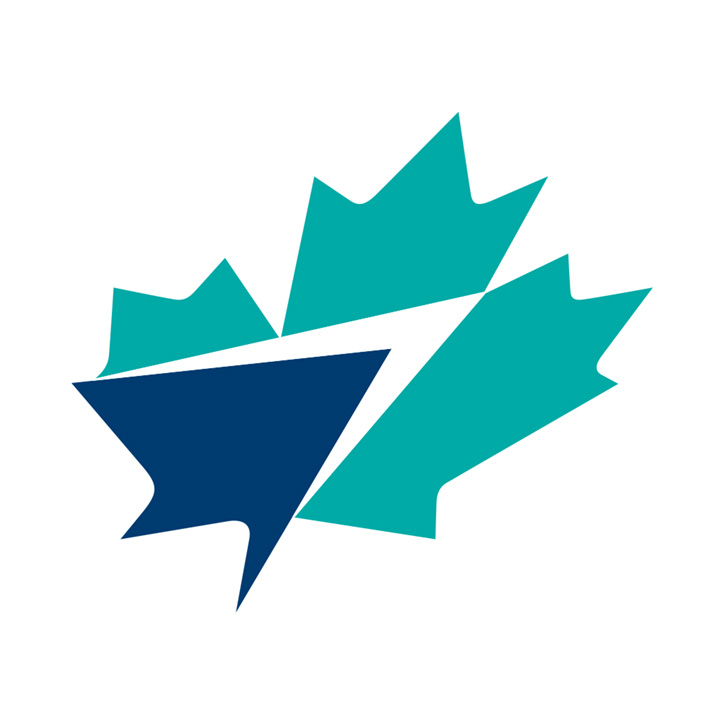 By WestJet|June 16, 2022|6 min read
By WestJet|June 16, 2022|6 min readThe WestJet Group’s strategic path forward for our guests, employees and the communities we serve
The WestJet Group yesterday brought together leaders, representing all parts of the operations and business, to hear directly from Chief Executive Officer (CEO), Alexis von Hoensbroech, as he shared plans for growth into the COVID recovery, and the airline’s commitment to embracing its cost-conscious roots in service of affordable air travel for Canadians.
“The immediate priority is to ensure we are ready for the high volume of pent-up travel demand this summer,” said Alexis von Hoensbroech, CEO of the WestJet Group. “Equally important is charting a path that continues to grow WestJet as the friendly, reliable and affordable airline our guests know and love.”
Since arriving on February 15, 2022, von Hoensbroech spent his first 100 days getting to know the airline’s people, guests and network. Joining at a critical inflection point as the WestJet Group emerges from the pandemic, the executive team around von Hoensbroech and WestJet’s board of directors undertook a strategic review to determine the best course for sustained future success for the airline and its people.
“WestJet is strong foundationally, having weathered the pandemic as perhaps the world’s only airline of scale that did not accept sector-specific government funding or issue any new equity or debt. We’re now at an exciting and pivotal moment for the industry and our airline,” continued von Hoensbroech. “As we emerge from the pandemic, the world around us is changing with rising inflation and instability from the war in Ukraine. We are also facing industry-specific challenges, including spiking oil prices and staffing shortages at airports.”
The WestJet Group’s strategic growth plans
Through the strategic review, the airline looked to historical strengths to secure future success, honing in on a focused network and strategy; an unrelenting cost commitment; and a consistent, superior guest experience.
To build upon the reasons why guests choose WestJet and drive future growth, WestJet will renew its focus on:
- Growth as a low-cost carrier that is friendly, reliable and modern
- Shifting resources to significantly grow its presence and network in the West, fostering its undisputed status as the home-team carrier of Western Canada offering more direct, non-stop flights to communities
- Investing further in leisure and sun flying as a priority across Canada, including through the acquisition of Sunwing, following regulatory approval
- Investing in technology and radical digitalization to improve guest experience and simplify internal processes to ensure meaningful and engaging jobs for its people
- Redoubling efforts to maintain its successful and highly productive low-cost structure and culture, to ensure relentless competitiveness and affordability for guests
To match its commercial strategies, the airline will centre its existing widebody 787 Dreamliner fleet around Western Canada and, for the time being, pause further investment into incremental Dreamliners to focus instead on additional narrowbody growth. In addition to the more than 30 Boeing 737 MAX aircraft that the airline will receive over the coming years, including 15 in 2022 alone, WestJet is working towards a substantial additional narrow body order.
The airline will maintain its current premium offerings, with a focus on strengthening its premium leisure segment and corporate premium in the West. The focus of WestJet’s regional fleet of De Haviland Q400 aircraft will be shifted and rightsized to focus on Western Canada, removing complexity from operations, and prioritizing the airline’s commitment to enhance Western Canada’s connectivity.
Network changes are complex and will be phased in over an extended period of time. The airline is committed to engaging with communities and stakeholders in these plans. Guests can anticipate seeing changes gradually implemented by summer 2023.
“We will deploy our aircraft where they can be of greatest service to Canadians,” explained von Hoensbroech. “While we will be investing the majority of our fleet in the West, as a national airline we will maintain a significant presence in the Eastern provinces, primarily through direct connections to our Western cities, while significantly enhancing our network to leisure and sun destinations, including through our acquisition of Sunwing.”
WestJet will also continue to significantly scale other areas of the business that remain critical, namely WestJet Cargo, Loyalty, WestJet Vacations and Swoop, it’s ultra-low-cost carrier. The acquisition of Sunwing will facilitate the scaling of WestJet Vacations and Swoop.
“Swoop is an important part of our strategy with a tremendous cost structure, and we still have plenty of room to grow and bring lower fares to our guests,” added von Hoensbroech. “WestJet and Swoop will run more complementary networks and collectively meet the demand of leisure travellers.”
Strengthening the airline’s leadership team, the WestJet Group announced the addition of Bob Cummings as President of Swoop on April 13, along with Kirsten de Bruijn, Executive Vice-President, Cargo on April 5 and Karl Schuster, Executive Vice-President and Chief Loyalty Officer late last year.
“WestJet’s low-cost roots have been the foundation of the historical success of our company. As we realize our ambitious growth plans, we will bring more air service to Canadian communities and connect more people to what matters most, through friendly and affordable air travel,” concluded von Hoensbroech.
Strengthening the airline’s senior leadership team
To support the fulfillment of its strategic direction, the airline has further strengthened its senior leadership team with a number of new appointments:
Angela Avery, Group EVP and Chief People, Corporate & Sustainability Officer
Angela Avery joined WestJet in February 2020 as General Counsel and Corporate Secretary. In her newly expanded role, she brings together complementary teams including People and Culture, Communications, Legal, Government, Regulatory, Community Investment, and Environment, Social and Governance (ESG). Avery will be leading an inclusive, engaged and purpose-led team focused on supporting all aspects of WestJet’s business and meeting the needs of the communities that the WestJet Group serves.
With more than 25 years of legal and commercial leadership experience across multiple industries, Avery has led transactions totalling more than $25 billion and has an extensive regulatory and compliance background. Avery joined WestJet from Athabasca Oil Corporation where she was responsible for legal, business development, human resources as well as marketing and transportation. Her international experience includes an appointment to litigate war reparations at the United Nations. She is called to the bar in New York and Alberta and received a Queen’s Counsel designation in 2022.
Christian Novosel, Chief Digital Officer
Christian Novosel will join the executive leadership team in August. Responsible for Digital Technology Delivery, Data Analytics and Business Intelligence and the Group Project Management Office, he will be integral to the ongoing development and delivery of WestJet’s enterprise-wide digital transformation for both its guests and people.
Novosel joins WestJet with almost 20 years of aviation experience most recently serving as Head of Corporate Development and Chief Data Officer for Austrian Airlines. In this role, he established the airline’s centralized digital team and led several strategic and innovating processes to implement digital solutions across the organization.
Natalie Farand, Chief Experience Officer
Natalie Farand will take on the newly created role of Chief Experience Officer (CXO). Led by Farand, the CXO team will define WestJet’s value proposition and enable WestJet to successfully engage stakeholders to activate a guest-centric vision and strategy.
In her eight years with WestJet, and most recently as WestJet’s Vice-President Guest Experience, Farand has led many digital functions from eCommerce, User Experience, Digital Marketing and Analytics. Farand introduced the User Experience discipline within WestJet, putting focus on the voice of the guest, and was responsible for the Digital Channel and Product strategic roadmaps and operations at WestJet, including the website, mobile app, chatbot, inflight entertainment system and eCommerce platforms.
Jeff Hagen, Vice-President Strategy and Fleet
Jeff Hagen, already part of the WestJet leadership team, will take on a new role as Vice-President, Strategy and Fleet. Responsible for leading WestJet’s strategic transformation to a low-cost carrier, the strategy team will also encompass the office of the CEO, enterprise strategy and fleet.
Hagen has been with WestJet for more than eight years and has held a variety of roles in that time including corporate development and planning, and head of investor relations. During this time, he played key roles in important company milestones including the airline’s purchase by Onex and the current Sunwing acquisition, awaiting regulatory approvals.





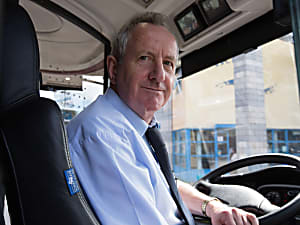

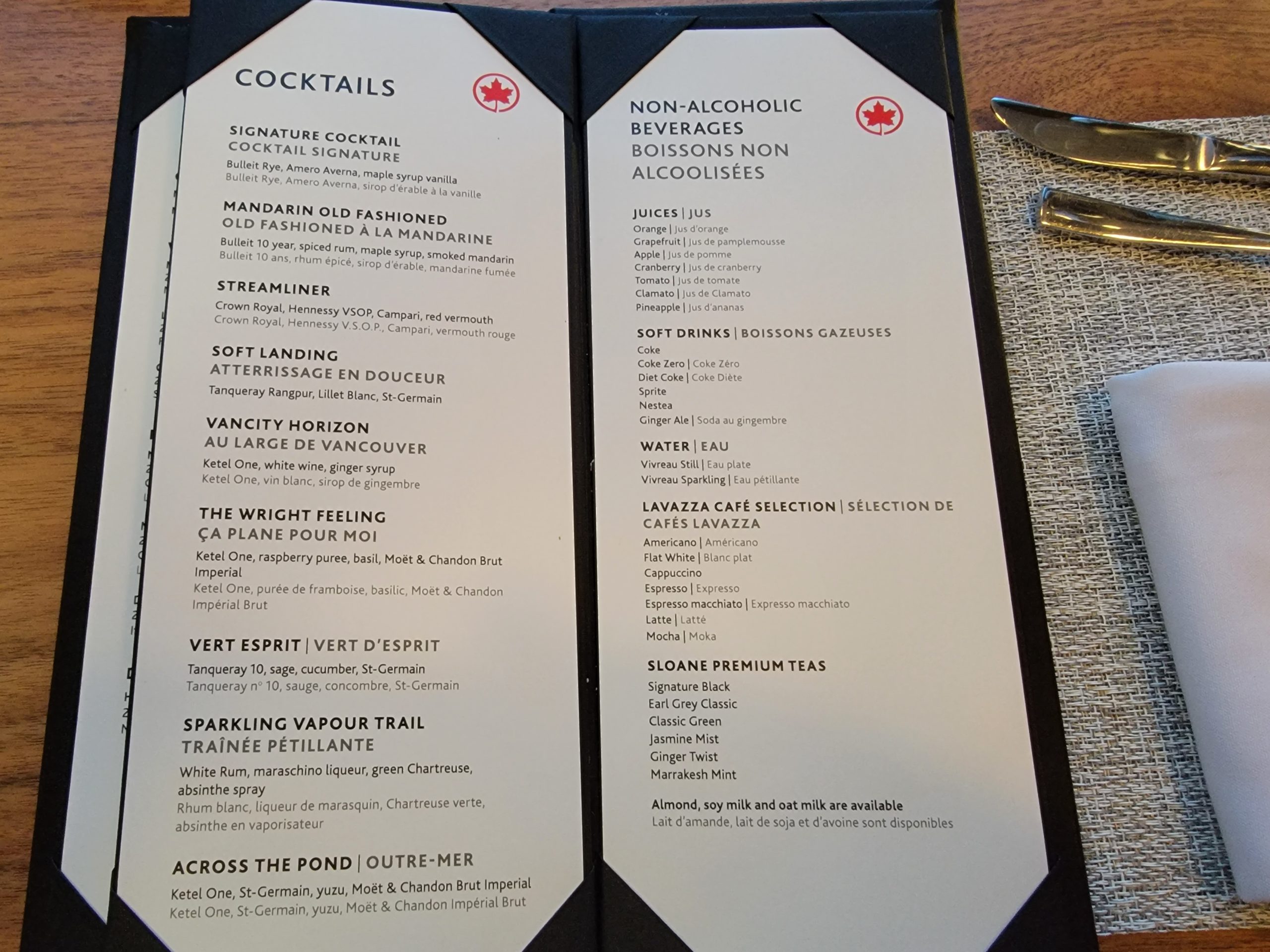
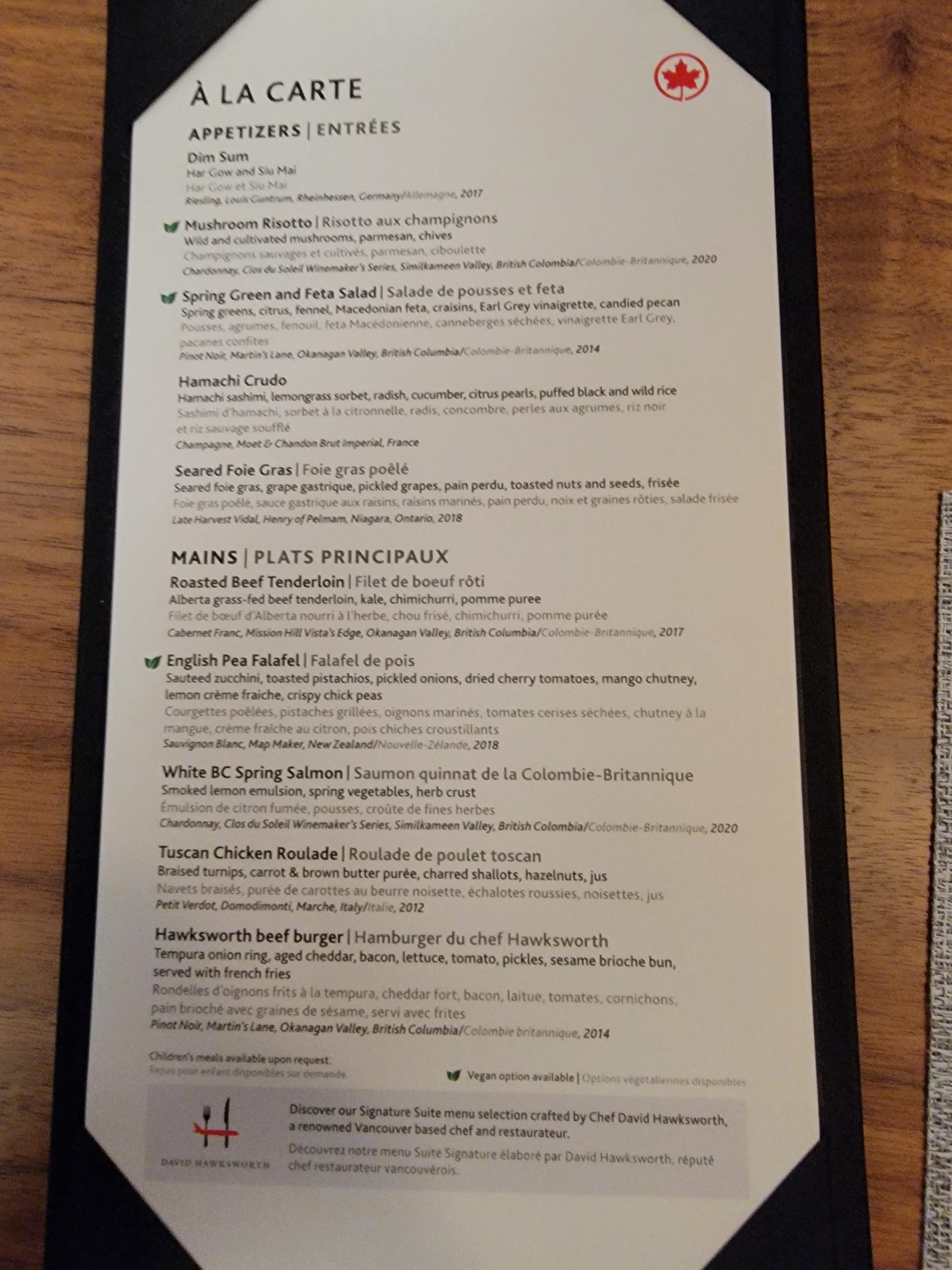



Lockdown Distractions
in Airline Aviation Forum
Posted
It will be interesting to see how the "real life" folks critique this show.